Detailed Export Marketing Plan for Austchilli Company Analysis
VerifiedAdded on 2020/03/16
|23
|6155
|52
Report
AI Summary
This report provides a detailed export marketing plan for Austchilli, focusing on the company's readiness to export avocado products. It begins with an internal analysis of Austchilli, examining financial statements, management commitment, available resources, and knowledge of export procedures. The report then analyzes the industry, identifying trade-offs and benefits associated with international market expansion, and evaluates the export potential of Austchilli's products through a SWOT analysis. The study identifies priority markets using economic modeling, resource analysis, and assessment of trading blocs. It also discusses the Ricardian model, market segmentation, and market targeting, and provides a determination matrix to assess market attractiveness based on price sensitivity, competition, market size, and growth potential. The report aims to guide Austchilli in making informed decisions about entering and succeeding in foreign markets.
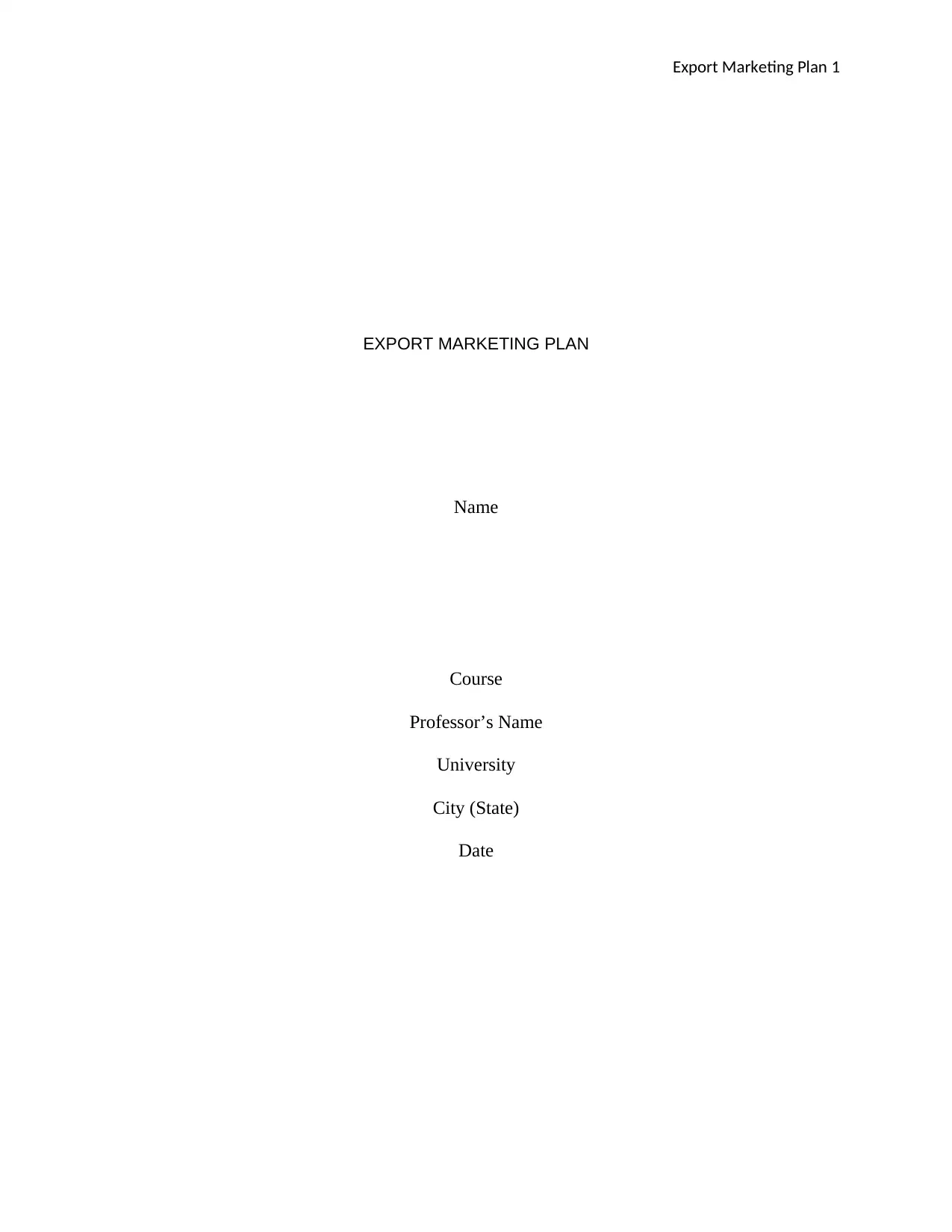
Export Marketing Plan 1
EXPORT MARKETING PLAN
Name
Course
Professor’s Name
University
City (State)
Date
EXPORT MARKETING PLAN
Name
Course
Professor’s Name
University
City (State)
Date
Paraphrase This Document
Need a fresh take? Get an instant paraphrase of this document with our AI Paraphraser
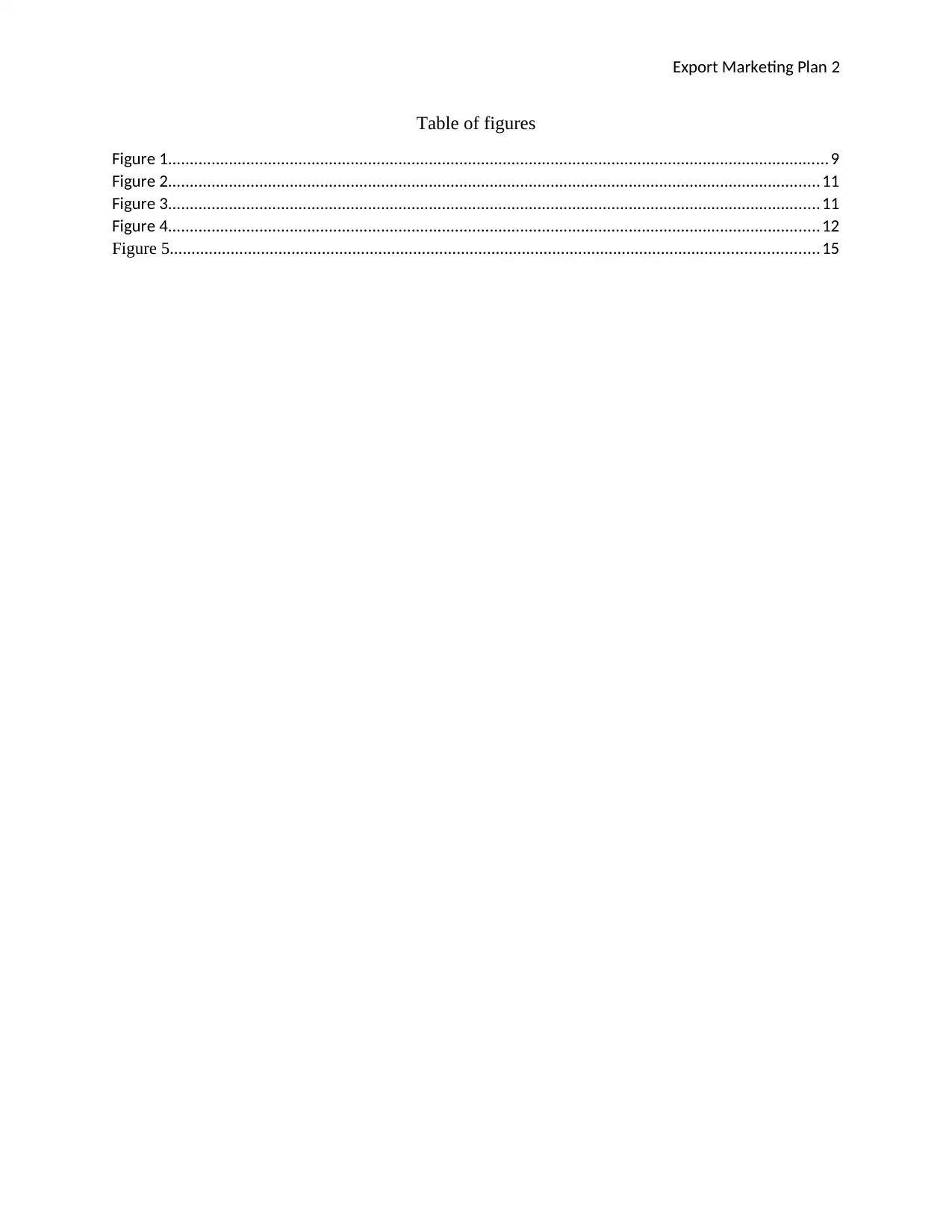
Export Marketing Plan 2
Table of figures
Figure 1........................................................................................................................................................9
Figure 2......................................................................................................................................................11
Figure 3......................................................................................................................................................11
Figure 4......................................................................................................................................................12
Figure 5.....................................................................................................................................................15
Table of figures
Figure 1........................................................................................................................................................9
Figure 2......................................................................................................................................................11
Figure 3......................................................................................................................................................11
Figure 4......................................................................................................................................................12
Figure 5.....................................................................................................................................................15
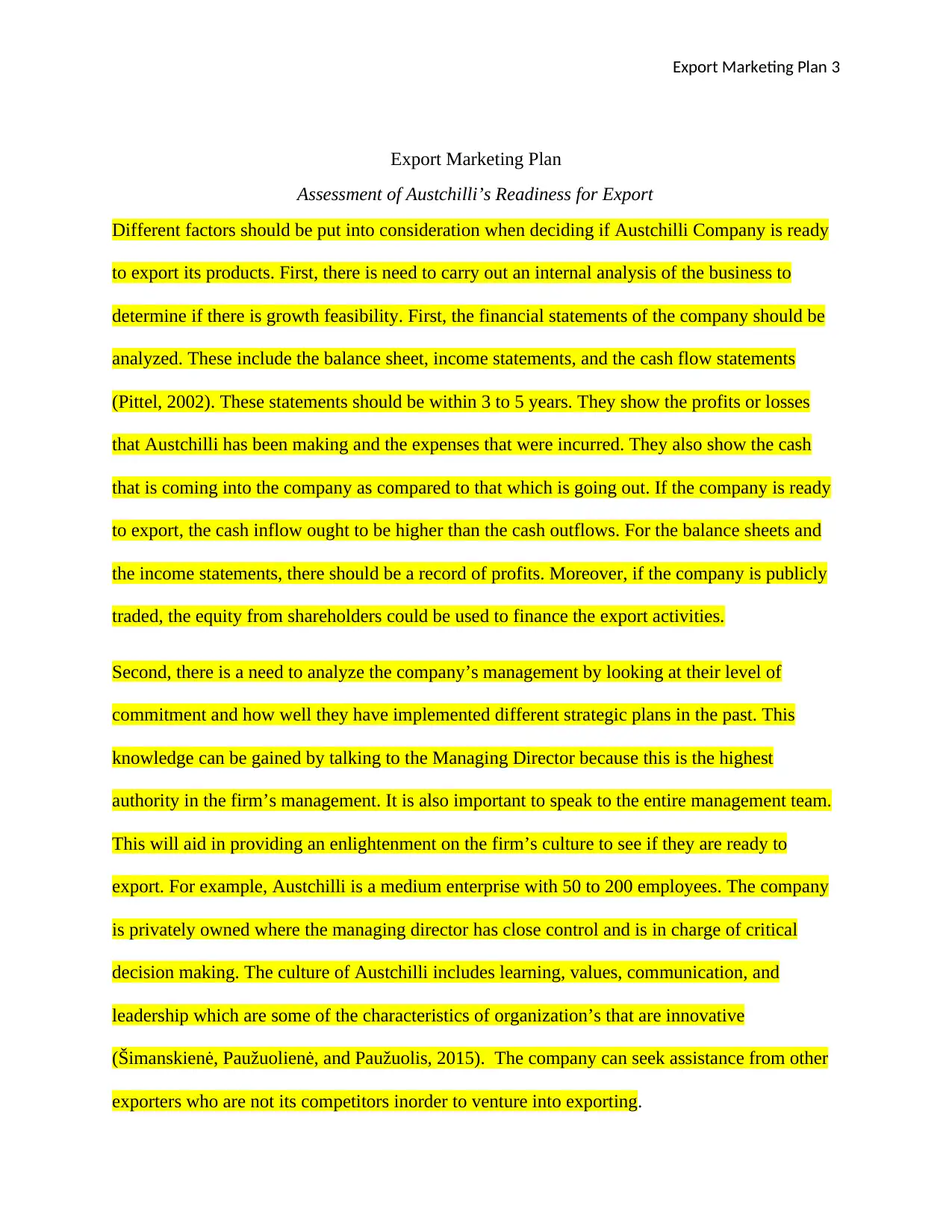
Export Marketing Plan 3
Export Marketing Plan
Assessment of Austchilli’s Readiness for Export
Different factors should be put into consideration when deciding if Austchilli Company is ready
to export its products. First, there is need to carry out an internal analysis of the business to
determine if there is growth feasibility. First, the financial statements of the company should be
analyzed. These include the balance sheet, income statements, and the cash flow statements
(Pittel, 2002). These statements should be within 3 to 5 years. They show the profits or losses
that Austchilli has been making and the expenses that were incurred. They also show the cash
that is coming into the company as compared to that which is going out. If the company is ready
to export, the cash inflow ought to be higher than the cash outflows. For the balance sheets and
the income statements, there should be a record of profits. Moreover, if the company is publicly
traded, the equity from shareholders could be used to finance the export activities.
Second, there is a need to analyze the company’s management by looking at their level of
commitment and how well they have implemented different strategic plans in the past. This
knowledge can be gained by talking to the Managing Director because this is the highest
authority in the firm’s management. It is also important to speak to the entire management team.
This will aid in providing an enlightenment on the firm’s culture to see if they are ready to
export. For example, Austchilli is a medium enterprise with 50 to 200 employees. The company
is privately owned where the managing director has close control and is in charge of critical
decision making. The culture of Austchilli includes learning, values, communication, and
leadership which are some of the characteristics of organization’s that are innovative
(Šimanskienė, Paužuolienė, and Paužuolis, 2015). The company can seek assistance from other
exporters who are not its competitors inorder to venture into exporting.
Export Marketing Plan
Assessment of Austchilli’s Readiness for Export
Different factors should be put into consideration when deciding if Austchilli Company is ready
to export its products. First, there is need to carry out an internal analysis of the business to
determine if there is growth feasibility. First, the financial statements of the company should be
analyzed. These include the balance sheet, income statements, and the cash flow statements
(Pittel, 2002). These statements should be within 3 to 5 years. They show the profits or losses
that Austchilli has been making and the expenses that were incurred. They also show the cash
that is coming into the company as compared to that which is going out. If the company is ready
to export, the cash inflow ought to be higher than the cash outflows. For the balance sheets and
the income statements, there should be a record of profits. Moreover, if the company is publicly
traded, the equity from shareholders could be used to finance the export activities.
Second, there is a need to analyze the company’s management by looking at their level of
commitment and how well they have implemented different strategic plans in the past. This
knowledge can be gained by talking to the Managing Director because this is the highest
authority in the firm’s management. It is also important to speak to the entire management team.
This will aid in providing an enlightenment on the firm’s culture to see if they are ready to
export. For example, Austchilli is a medium enterprise with 50 to 200 employees. The company
is privately owned where the managing director has close control and is in charge of critical
decision making. The culture of Austchilli includes learning, values, communication, and
leadership which are some of the characteristics of organization’s that are innovative
(Šimanskienė, Paužuolienė, and Paužuolis, 2015). The company can seek assistance from other
exporters who are not its competitors inorder to venture into exporting.
You're viewing a preview
Unlock full access by subscribing today!
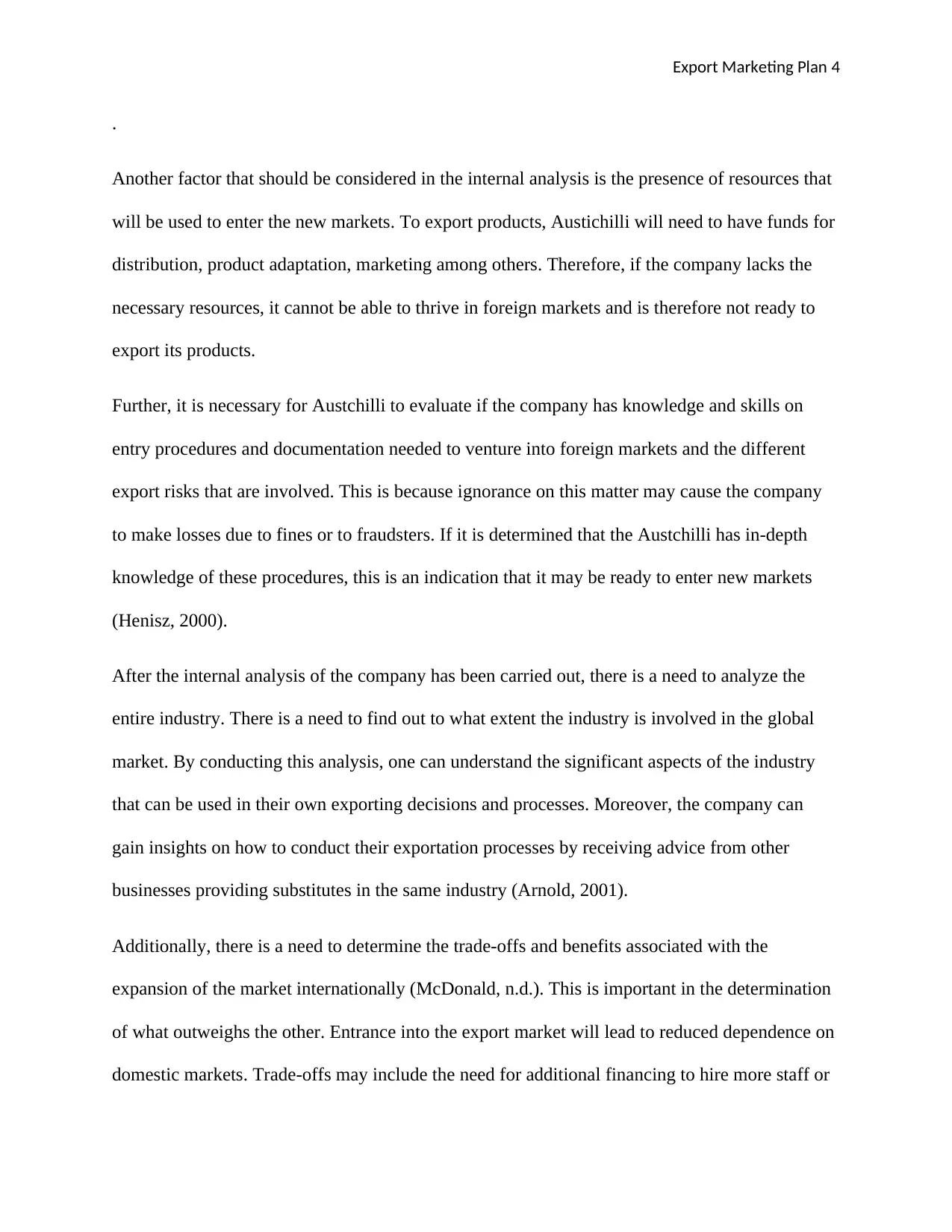
Export Marketing Plan 4
.
Another factor that should be considered in the internal analysis is the presence of resources that
will be used to enter the new markets. To export products, Austichilli will need to have funds for
distribution, product adaptation, marketing among others. Therefore, if the company lacks the
necessary resources, it cannot be able to thrive in foreign markets and is therefore not ready to
export its products.
Further, it is necessary for Austchilli to evaluate if the company has knowledge and skills on
entry procedures and documentation needed to venture into foreign markets and the different
export risks that are involved. This is because ignorance on this matter may cause the company
to make losses due to fines or to fraudsters. If it is determined that the Austchilli has in-depth
knowledge of these procedures, this is an indication that it may be ready to enter new markets
(Henisz, 2000).
After the internal analysis of the company has been carried out, there is a need to analyze the
entire industry. There is a need to find out to what extent the industry is involved in the global
market. By conducting this analysis, one can understand the significant aspects of the industry
that can be used in their own exporting decisions and processes. Moreover, the company can
gain insights on how to conduct their exportation processes by receiving advice from other
businesses providing substitutes in the same industry (Arnold, 2001).
Additionally, there is a need to determine the trade-offs and benefits associated with the
expansion of the market internationally (McDonald, n.d.). This is important in the determination
of what outweighs the other. Entrance into the export market will lead to reduced dependence on
domestic markets. Trade-offs may include the need for additional financing to hire more staff or
.
Another factor that should be considered in the internal analysis is the presence of resources that
will be used to enter the new markets. To export products, Austichilli will need to have funds for
distribution, product adaptation, marketing among others. Therefore, if the company lacks the
necessary resources, it cannot be able to thrive in foreign markets and is therefore not ready to
export its products.
Further, it is necessary for Austchilli to evaluate if the company has knowledge and skills on
entry procedures and documentation needed to venture into foreign markets and the different
export risks that are involved. This is because ignorance on this matter may cause the company
to make losses due to fines or to fraudsters. If it is determined that the Austchilli has in-depth
knowledge of these procedures, this is an indication that it may be ready to enter new markets
(Henisz, 2000).
After the internal analysis of the company has been carried out, there is a need to analyze the
entire industry. There is a need to find out to what extent the industry is involved in the global
market. By conducting this analysis, one can understand the significant aspects of the industry
that can be used in their own exporting decisions and processes. Moreover, the company can
gain insights on how to conduct their exportation processes by receiving advice from other
businesses providing substitutes in the same industry (Arnold, 2001).
Additionally, there is a need to determine the trade-offs and benefits associated with the
expansion of the market internationally (McDonald, n.d.). This is important in the determination
of what outweighs the other. Entrance into the export market will lead to reduced dependence on
domestic markets. Trade-offs may include the need for additional financing to hire more staff or
Paraphrase This Document
Need a fresh take? Get an instant paraphrase of this document with our AI Paraphraser
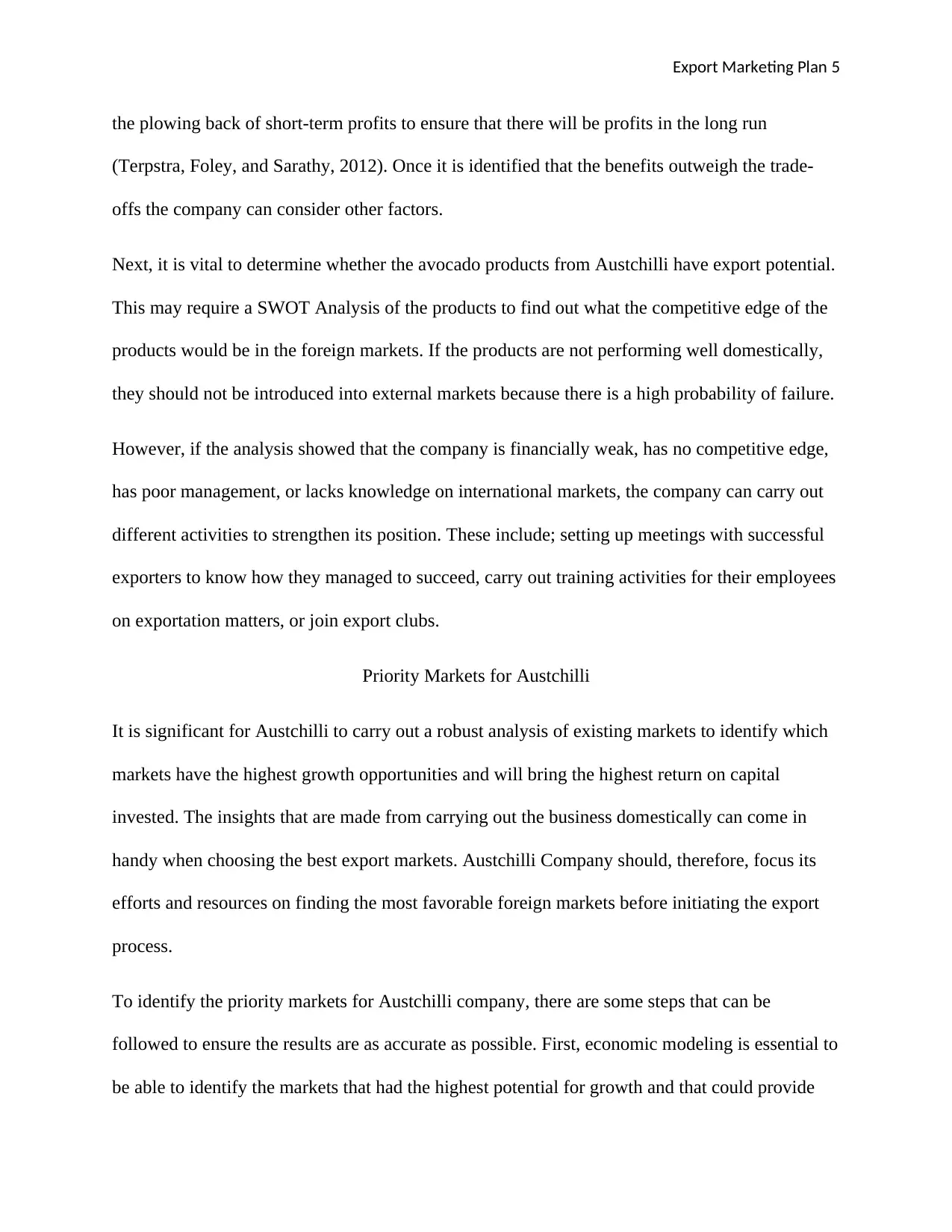
Export Marketing Plan 5
the plowing back of short-term profits to ensure that there will be profits in the long run
(Terpstra, Foley, and Sarathy, 2012). Once it is identified that the benefits outweigh the trade-
offs the company can consider other factors.
Next, it is vital to determine whether the avocado products from Austchilli have export potential.
This may require a SWOT Analysis of the products to find out what the competitive edge of the
products would be in the foreign markets. If the products are not performing well domestically,
they should not be introduced into external markets because there is a high probability of failure.
However, if the analysis showed that the company is financially weak, has no competitive edge,
has poor management, or lacks knowledge on international markets, the company can carry out
different activities to strengthen its position. These include; setting up meetings with successful
exporters to know how they managed to succeed, carry out training activities for their employees
on exportation matters, or join export clubs.
Priority Markets for Austchilli
It is significant for Austchilli to carry out a robust analysis of existing markets to identify which
markets have the highest growth opportunities and will bring the highest return on capital
invested. The insights that are made from carrying out the business domestically can come in
handy when choosing the best export markets. Austchilli Company should, therefore, focus its
efforts and resources on finding the most favorable foreign markets before initiating the export
process.
To identify the priority markets for Austchilli company, there are some steps that can be
followed to ensure the results are as accurate as possible. First, economic modeling is essential to
be able to identify the markets that had the highest potential for growth and that could provide
the plowing back of short-term profits to ensure that there will be profits in the long run
(Terpstra, Foley, and Sarathy, 2012). Once it is identified that the benefits outweigh the trade-
offs the company can consider other factors.
Next, it is vital to determine whether the avocado products from Austchilli have export potential.
This may require a SWOT Analysis of the products to find out what the competitive edge of the
products would be in the foreign markets. If the products are not performing well domestically,
they should not be introduced into external markets because there is a high probability of failure.
However, if the analysis showed that the company is financially weak, has no competitive edge,
has poor management, or lacks knowledge on international markets, the company can carry out
different activities to strengthen its position. These include; setting up meetings with successful
exporters to know how they managed to succeed, carry out training activities for their employees
on exportation matters, or join export clubs.
Priority Markets for Austchilli
It is significant for Austchilli to carry out a robust analysis of existing markets to identify which
markets have the highest growth opportunities and will bring the highest return on capital
invested. The insights that are made from carrying out the business domestically can come in
handy when choosing the best export markets. Austchilli Company should, therefore, focus its
efforts and resources on finding the most favorable foreign markets before initiating the export
process.
To identify the priority markets for Austchilli company, there are some steps that can be
followed to ensure the results are as accurate as possible. First, economic modeling is essential to
be able to identify the markets that had the highest potential for growth and that could provide
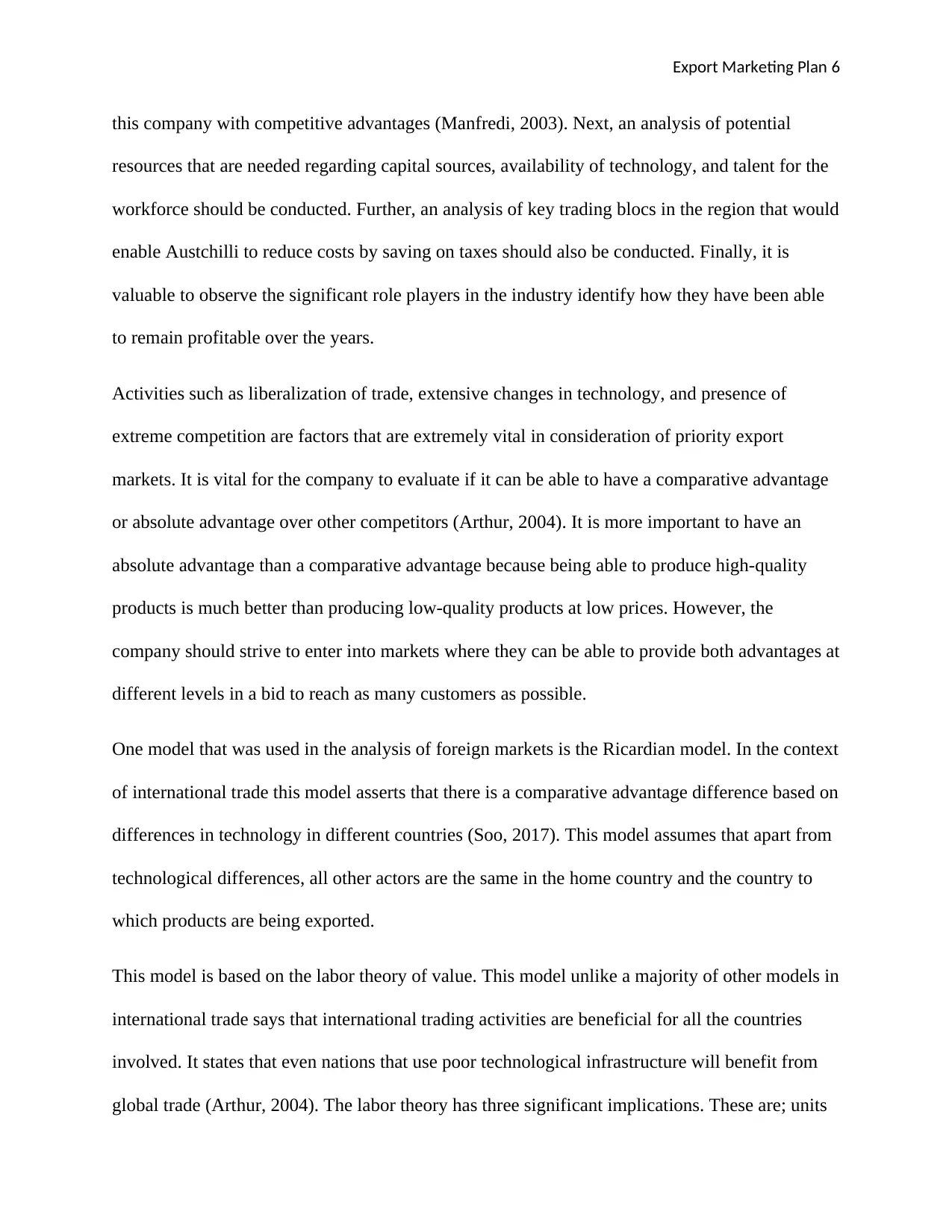
Export Marketing Plan 6
this company with competitive advantages (Manfredi, 2003). Next, an analysis of potential
resources that are needed regarding capital sources, availability of technology, and talent for the
workforce should be conducted. Further, an analysis of key trading blocs in the region that would
enable Austchilli to reduce costs by saving on taxes should also be conducted. Finally, it is
valuable to observe the significant role players in the industry identify how they have been able
to remain profitable over the years.
Activities such as liberalization of trade, extensive changes in technology, and presence of
extreme competition are factors that are extremely vital in consideration of priority export
markets. It is vital for the company to evaluate if it can be able to have a comparative advantage
or absolute advantage over other competitors (Arthur, 2004). It is more important to have an
absolute advantage than a comparative advantage because being able to produce high-quality
products is much better than producing low-quality products at low prices. However, the
company should strive to enter into markets where they can be able to provide both advantages at
different levels in a bid to reach as many customers as possible.
One model that was used in the analysis of foreign markets is the Ricardian model. In the context
of international trade this model asserts that there is a comparative advantage difference based on
differences in technology in different countries (Soo, 2017). This model assumes that apart from
technological differences, all other actors are the same in the home country and the country to
which products are being exported.
This model is based on the labor theory of value. This model unlike a majority of other models in
international trade says that international trading activities are beneficial for all the countries
involved. It states that even nations that use poor technological infrastructure will benefit from
global trade (Arthur, 2004). The labor theory has three significant implications. These are; units
this company with competitive advantages (Manfredi, 2003). Next, an analysis of potential
resources that are needed regarding capital sources, availability of technology, and talent for the
workforce should be conducted. Further, an analysis of key trading blocs in the region that would
enable Austchilli to reduce costs by saving on taxes should also be conducted. Finally, it is
valuable to observe the significant role players in the industry identify how they have been able
to remain profitable over the years.
Activities such as liberalization of trade, extensive changes in technology, and presence of
extreme competition are factors that are extremely vital in consideration of priority export
markets. It is vital for the company to evaluate if it can be able to have a comparative advantage
or absolute advantage over other competitors (Arthur, 2004). It is more important to have an
absolute advantage than a comparative advantage because being able to produce high-quality
products is much better than producing low-quality products at low prices. However, the
company should strive to enter into markets where they can be able to provide both advantages at
different levels in a bid to reach as many customers as possible.
One model that was used in the analysis of foreign markets is the Ricardian model. In the context
of international trade this model asserts that there is a comparative advantage difference based on
differences in technology in different countries (Soo, 2017). This model assumes that apart from
technological differences, all other actors are the same in the home country and the country to
which products are being exported.
This model is based on the labor theory of value. This model unlike a majority of other models in
international trade says that international trading activities are beneficial for all the countries
involved. It states that even nations that use poor technological infrastructure will benefit from
global trade (Arthur, 2004). The labor theory has three significant implications. These are; units
You're viewing a preview
Unlock full access by subscribing today!
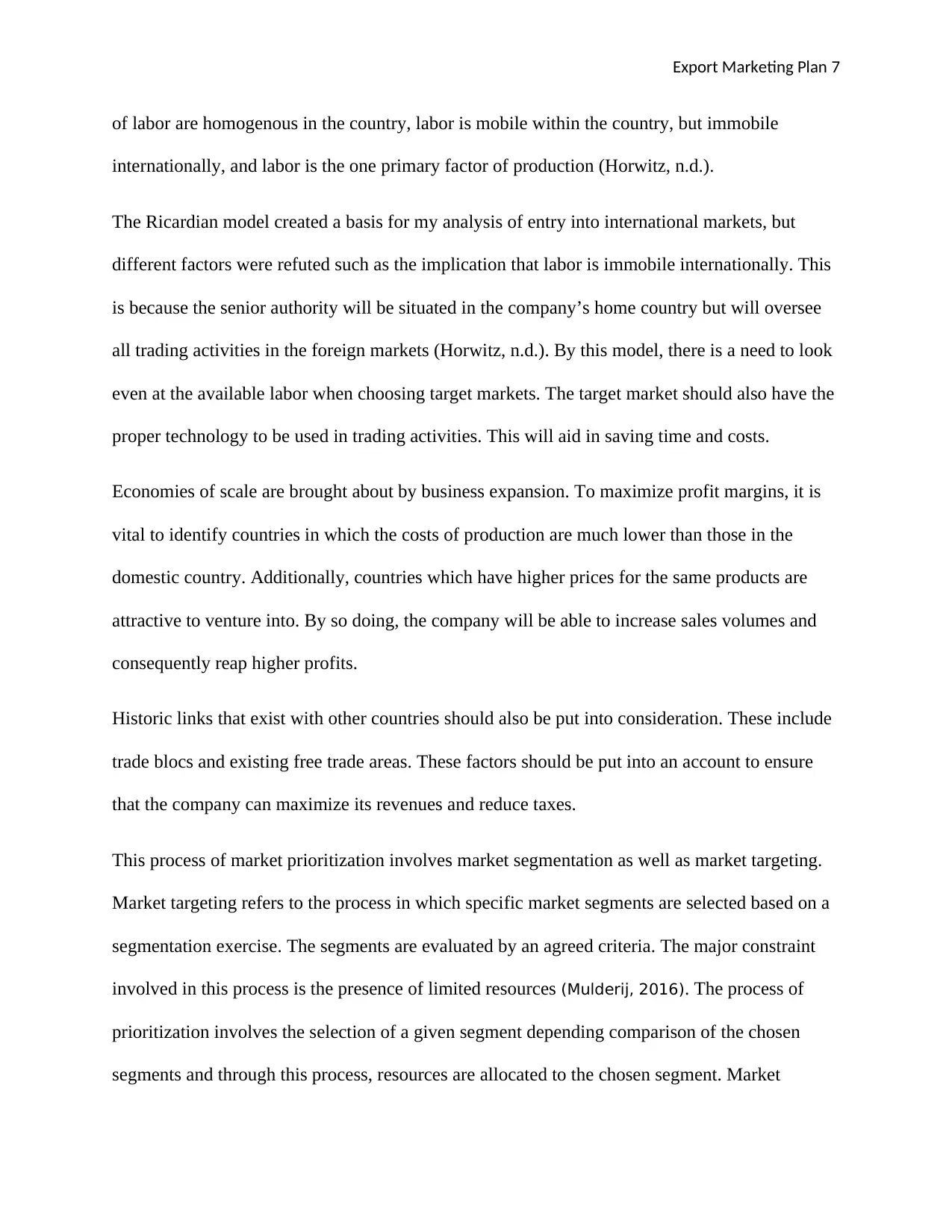
Export Marketing Plan 7
of labor are homogenous in the country, labor is mobile within the country, but immobile
internationally, and labor is the one primary factor of production (Horwitz, n.d.).
The Ricardian model created a basis for my analysis of entry into international markets, but
different factors were refuted such as the implication that labor is immobile internationally. This
is because the senior authority will be situated in the company’s home country but will oversee
all trading activities in the foreign markets (Horwitz, n.d.). By this model, there is a need to look
even at the available labor when choosing target markets. The target market should also have the
proper technology to be used in trading activities. This will aid in saving time and costs.
Economies of scale are brought about by business expansion. To maximize profit margins, it is
vital to identify countries in which the costs of production are much lower than those in the
domestic country. Additionally, countries which have higher prices for the same products are
attractive to venture into. By so doing, the company will be able to increase sales volumes and
consequently reap higher profits.
Historic links that exist with other countries should also be put into consideration. These include
trade blocs and existing free trade areas. These factors should be put into an account to ensure
that the company can maximize its revenues and reduce taxes.
This process of market prioritization involves market segmentation as well as market targeting.
Market targeting refers to the process in which specific market segments are selected based on a
segmentation exercise. The segments are evaluated by an agreed criteria. The major constraint
involved in this process is the presence of limited resources (Mulderij, 2016). The process of
prioritization involves the selection of a given segment depending comparison of the chosen
segments and through this process, resources are allocated to the chosen segment. Market
of labor are homogenous in the country, labor is mobile within the country, but immobile
internationally, and labor is the one primary factor of production (Horwitz, n.d.).
The Ricardian model created a basis for my analysis of entry into international markets, but
different factors were refuted such as the implication that labor is immobile internationally. This
is because the senior authority will be situated in the company’s home country but will oversee
all trading activities in the foreign markets (Horwitz, n.d.). By this model, there is a need to look
even at the available labor when choosing target markets. The target market should also have the
proper technology to be used in trading activities. This will aid in saving time and costs.
Economies of scale are brought about by business expansion. To maximize profit margins, it is
vital to identify countries in which the costs of production are much lower than those in the
domestic country. Additionally, countries which have higher prices for the same products are
attractive to venture into. By so doing, the company will be able to increase sales volumes and
consequently reap higher profits.
Historic links that exist with other countries should also be put into consideration. These include
trade blocs and existing free trade areas. These factors should be put into an account to ensure
that the company can maximize its revenues and reduce taxes.
This process of market prioritization involves market segmentation as well as market targeting.
Market targeting refers to the process in which specific market segments are selected based on a
segmentation exercise. The segments are evaluated by an agreed criteria. The major constraint
involved in this process is the presence of limited resources (Mulderij, 2016). The process of
prioritization involves the selection of a given segment depending comparison of the chosen
segments and through this process, resources are allocated to the chosen segment. Market
Paraphrase This Document
Need a fresh take? Get an instant paraphrase of this document with our AI Paraphraser
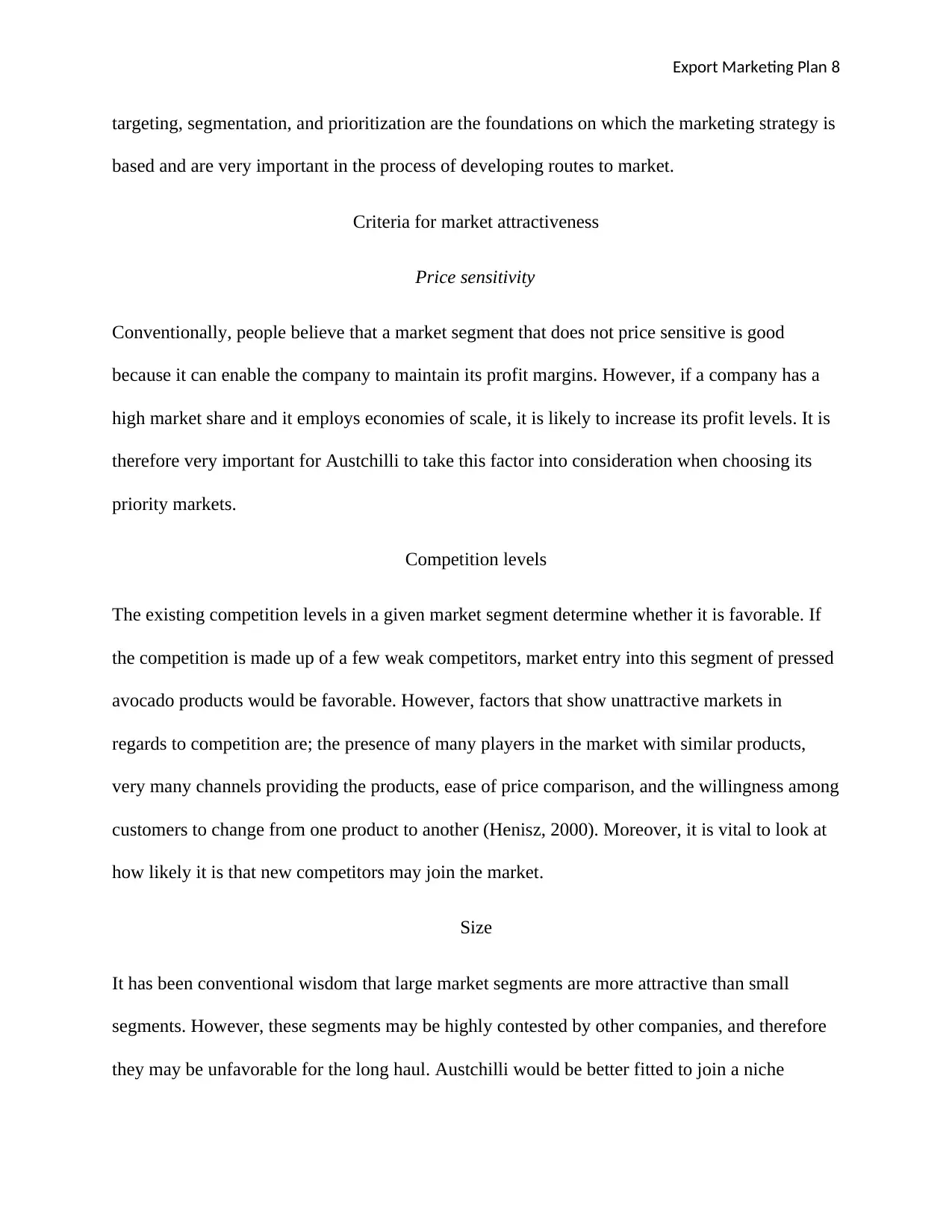
Export Marketing Plan 8
targeting, segmentation, and prioritization are the foundations on which the marketing strategy is
based and are very important in the process of developing routes to market.
Criteria for market attractiveness
Price sensitivity
Conventionally, people believe that a market segment that does not price sensitive is good
because it can enable the company to maintain its profit margins. However, if a company has a
high market share and it employs economies of scale, it is likely to increase its profit levels. It is
therefore very important for Austchilli to take this factor into consideration when choosing its
priority markets.
Competition levels
The existing competition levels in a given market segment determine whether it is favorable. If
the competition is made up of a few weak competitors, market entry into this segment of pressed
avocado products would be favorable. However, factors that show unattractive markets in
regards to competition are; the presence of many players in the market with similar products,
very many channels providing the products, ease of price comparison, and the willingness among
customers to change from one product to another (Henisz, 2000). Moreover, it is vital to look at
how likely it is that new competitors may join the market.
Size
It has been conventional wisdom that large market segments are more attractive than small
segments. However, these segments may be highly contested by other companies, and therefore
they may be unfavorable for the long haul. Austchilli would be better fitted to join a niche
targeting, segmentation, and prioritization are the foundations on which the marketing strategy is
based and are very important in the process of developing routes to market.
Criteria for market attractiveness
Price sensitivity
Conventionally, people believe that a market segment that does not price sensitive is good
because it can enable the company to maintain its profit margins. However, if a company has a
high market share and it employs economies of scale, it is likely to increase its profit levels. It is
therefore very important for Austchilli to take this factor into consideration when choosing its
priority markets.
Competition levels
The existing competition levels in a given market segment determine whether it is favorable. If
the competition is made up of a few weak competitors, market entry into this segment of pressed
avocado products would be favorable. However, factors that show unattractive markets in
regards to competition are; the presence of many players in the market with similar products,
very many channels providing the products, ease of price comparison, and the willingness among
customers to change from one product to another (Henisz, 2000). Moreover, it is vital to look at
how likely it is that new competitors may join the market.
Size
It has been conventional wisdom that large market segments are more attractive than small
segments. However, these segments may be highly contested by other companies, and therefore
they may be unfavorable for the long haul. Austchilli would be better fitted to join a niche
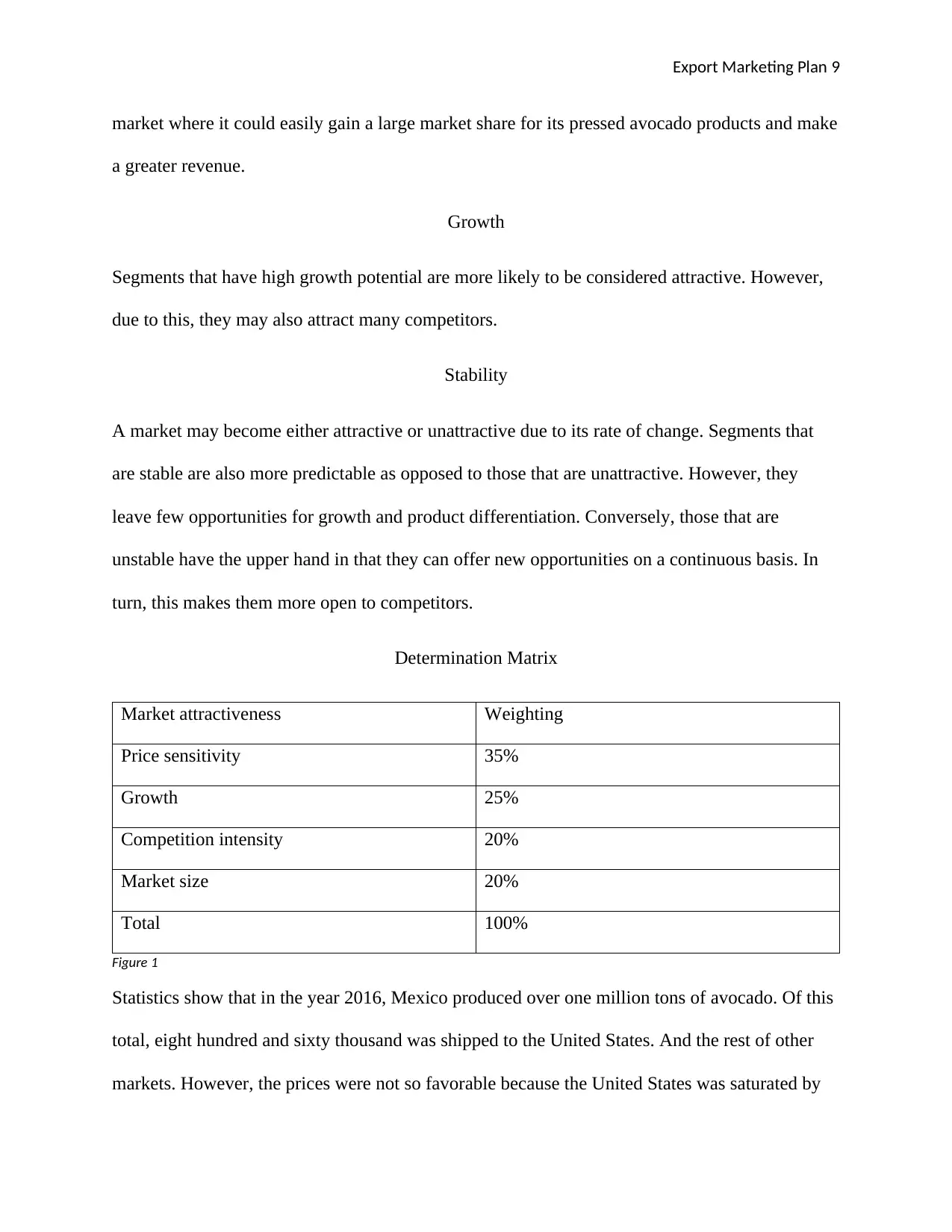
Export Marketing Plan 9
market where it could easily gain a large market share for its pressed avocado products and make
a greater revenue.
Growth
Segments that have high growth potential are more likely to be considered attractive. However,
due to this, they may also attract many competitors.
Stability
A market may become either attractive or unattractive due to its rate of change. Segments that
are stable are also more predictable as opposed to those that are unattractive. However, they
leave few opportunities for growth and product differentiation. Conversely, those that are
unstable have the upper hand in that they can offer new opportunities on a continuous basis. In
turn, this makes them more open to competitors.
Determination Matrix
Market attractiveness Weighting
Price sensitivity 35%
Growth 25%
Competition intensity 20%
Market size 20%
Total 100%
Figure 1
Statistics show that in the year 2016, Mexico produced over one million tons of avocado. Of this
total, eight hundred and sixty thousand was shipped to the United States. And the rest of other
markets. However, the prices were not so favorable because the United States was saturated by
market where it could easily gain a large market share for its pressed avocado products and make
a greater revenue.
Growth
Segments that have high growth potential are more likely to be considered attractive. However,
due to this, they may also attract many competitors.
Stability
A market may become either attractive or unattractive due to its rate of change. Segments that
are stable are also more predictable as opposed to those that are unattractive. However, they
leave few opportunities for growth and product differentiation. Conversely, those that are
unstable have the upper hand in that they can offer new opportunities on a continuous basis. In
turn, this makes them more open to competitors.
Determination Matrix
Market attractiveness Weighting
Price sensitivity 35%
Growth 25%
Competition intensity 20%
Market size 20%
Total 100%
Figure 1
Statistics show that in the year 2016, Mexico produced over one million tons of avocado. Of this
total, eight hundred and sixty thousand was shipped to the United States. And the rest of other
markets. However, the prices were not so favorable because the United States was saturated by
You're viewing a preview
Unlock full access by subscribing today!
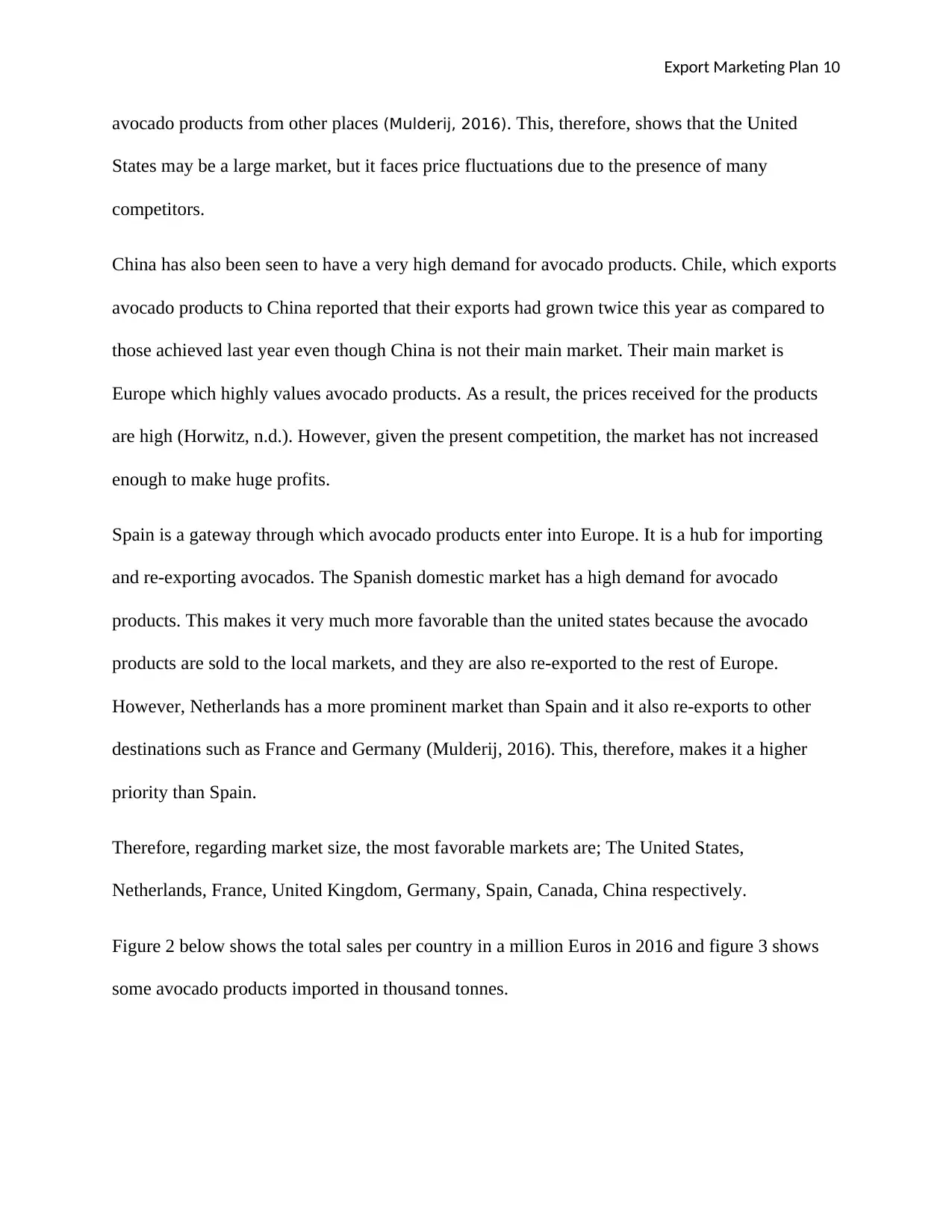
Export Marketing Plan 10
avocado products from other places (Mulderij, 2016). This, therefore, shows that the United
States may be a large market, but it faces price fluctuations due to the presence of many
competitors.
China has also been seen to have a very high demand for avocado products. Chile, which exports
avocado products to China reported that their exports had grown twice this year as compared to
those achieved last year even though China is not their main market. Their main market is
Europe which highly values avocado products. As a result, the prices received for the products
are high (Horwitz, n.d.). However, given the present competition, the market has not increased
enough to make huge profits.
Spain is a gateway through which avocado products enter into Europe. It is a hub for importing
and re-exporting avocados. The Spanish domestic market has a high demand for avocado
products. This makes it very much more favorable than the united states because the avocado
products are sold to the local markets, and they are also re-exported to the rest of Europe.
However, Netherlands has a more prominent market than Spain and it also re-exports to other
destinations such as France and Germany (Mulderij, 2016). This, therefore, makes it a higher
priority than Spain.
Therefore, regarding market size, the most favorable markets are; The United States,
Netherlands, France, United Kingdom, Germany, Spain, Canada, China respectively.
Figure 2 below shows the total sales per country in a million Euros in 2016 and figure 3 shows
some avocado products imported in thousand tonnes.
avocado products from other places (Mulderij, 2016). This, therefore, shows that the United
States may be a large market, but it faces price fluctuations due to the presence of many
competitors.
China has also been seen to have a very high demand for avocado products. Chile, which exports
avocado products to China reported that their exports had grown twice this year as compared to
those achieved last year even though China is not their main market. Their main market is
Europe which highly values avocado products. As a result, the prices received for the products
are high (Horwitz, n.d.). However, given the present competition, the market has not increased
enough to make huge profits.
Spain is a gateway through which avocado products enter into Europe. It is a hub for importing
and re-exporting avocados. The Spanish domestic market has a high demand for avocado
products. This makes it very much more favorable than the united states because the avocado
products are sold to the local markets, and they are also re-exported to the rest of Europe.
However, Netherlands has a more prominent market than Spain and it also re-exports to other
destinations such as France and Germany (Mulderij, 2016). This, therefore, makes it a higher
priority than Spain.
Therefore, regarding market size, the most favorable markets are; The United States,
Netherlands, France, United Kingdom, Germany, Spain, Canada, China respectively.
Figure 2 below shows the total sales per country in a million Euros in 2016 and figure 3 shows
some avocado products imported in thousand tonnes.
Paraphrase This Document
Need a fresh take? Get an instant paraphrase of this document with our AI Paraphraser
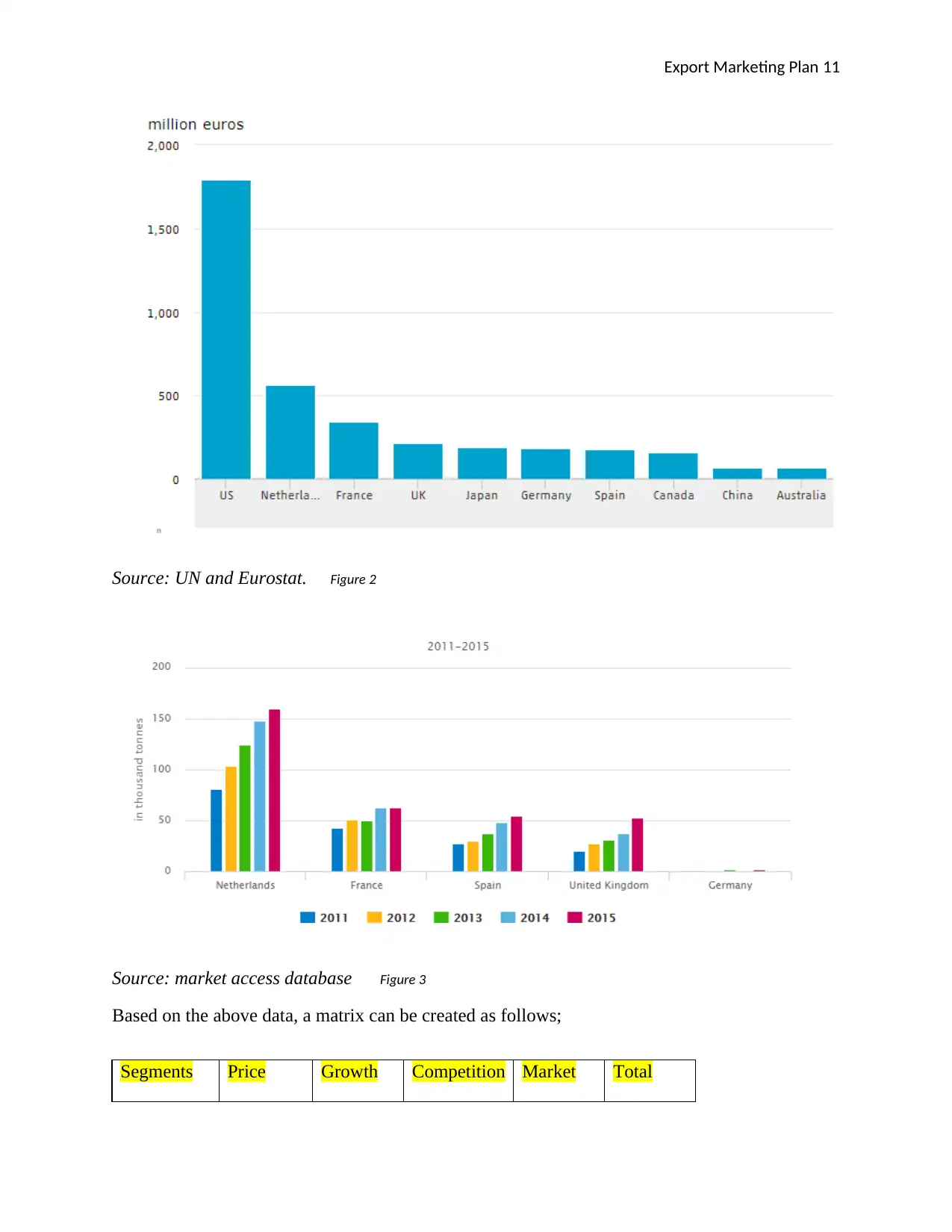
Export Marketing Plan 11
Source: UN and Eurostat. Figure 2
Source: market access database Figure 3
Based on the above data, a matrix can be created as follows;
Segments Price Growth Competition Market Total
Source: UN and Eurostat. Figure 2
Source: market access database Figure 3
Based on the above data, a matrix can be created as follows;
Segments Price Growth Competition Market Total
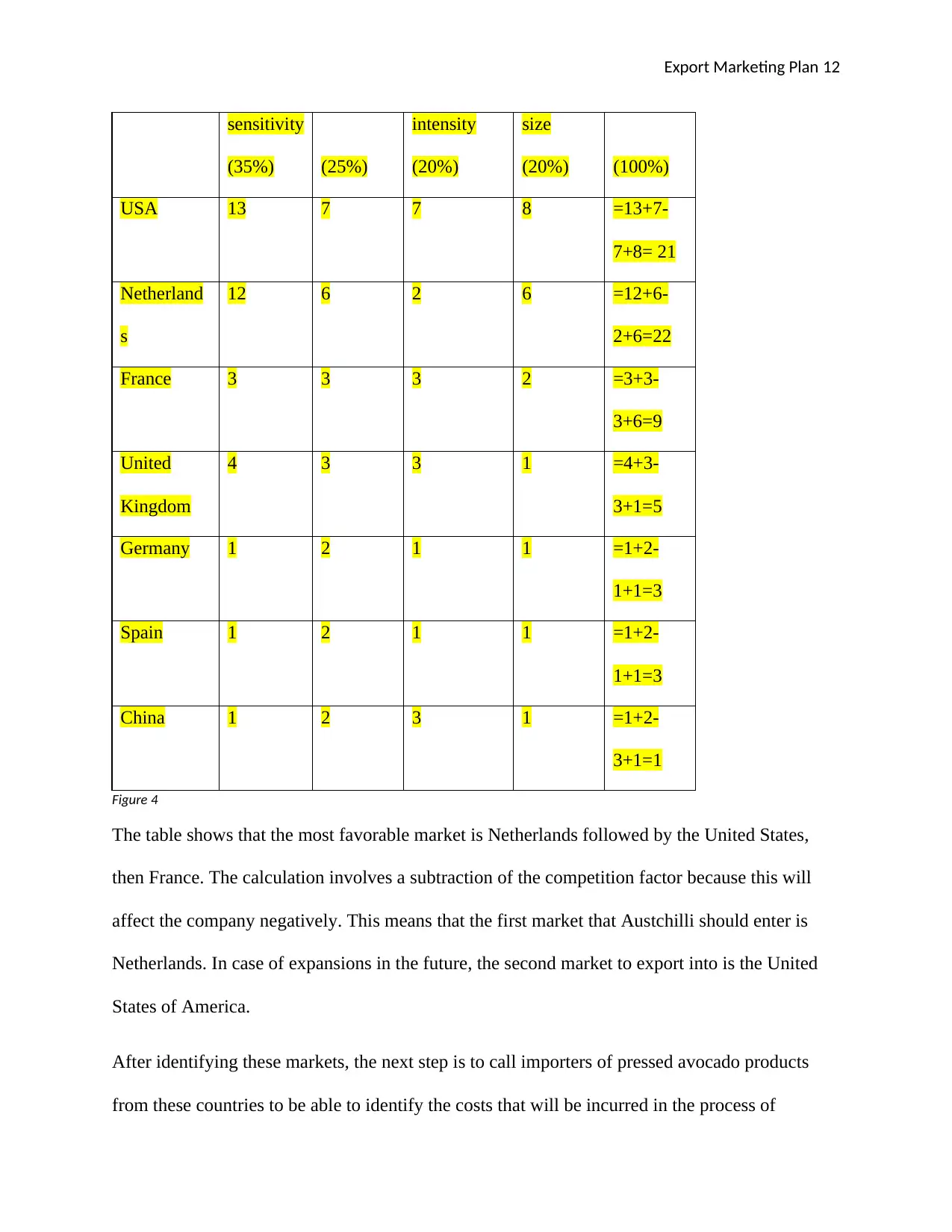
Export Marketing Plan 12
sensitivity
(35%) (25%)
intensity
(20%)
size
(20%) (100%)
USA 13 7 7 8 =13+7-
7+8= 21
Netherland
s
12 6 2 6 =12+6-
2+6=22
France 3 3 3 2 =3+3-
3+6=9
United
Kingdom
4 3 3 1 =4+3-
3+1=5
Germany 1 2 1 1 =1+2-
1+1=3
Spain 1 2 1 1 =1+2-
1+1=3
China 1 2 3 1 =1+2-
3+1=1
Figure 4
The table shows that the most favorable market is Netherlands followed by the United States,
then France. The calculation involves a subtraction of the competition factor because this will
affect the company negatively. This means that the first market that Austchilli should enter is
Netherlands. In case of expansions in the future, the second market to export into is the United
States of America.
After identifying these markets, the next step is to call importers of pressed avocado products
from these countries to be able to identify the costs that will be incurred in the process of
sensitivity
(35%) (25%)
intensity
(20%)
size
(20%) (100%)
USA 13 7 7 8 =13+7-
7+8= 21
Netherland
s
12 6 2 6 =12+6-
2+6=22
France 3 3 3 2 =3+3-
3+6=9
United
Kingdom
4 3 3 1 =4+3-
3+1=5
Germany 1 2 1 1 =1+2-
1+1=3
Spain 1 2 1 1 =1+2-
1+1=3
China 1 2 3 1 =1+2-
3+1=1
Figure 4
The table shows that the most favorable market is Netherlands followed by the United States,
then France. The calculation involves a subtraction of the competition factor because this will
affect the company negatively. This means that the first market that Austchilli should enter is
Netherlands. In case of expansions in the future, the second market to export into is the United
States of America.
After identifying these markets, the next step is to call importers of pressed avocado products
from these countries to be able to identify the costs that will be incurred in the process of
You're viewing a preview
Unlock full access by subscribing today!
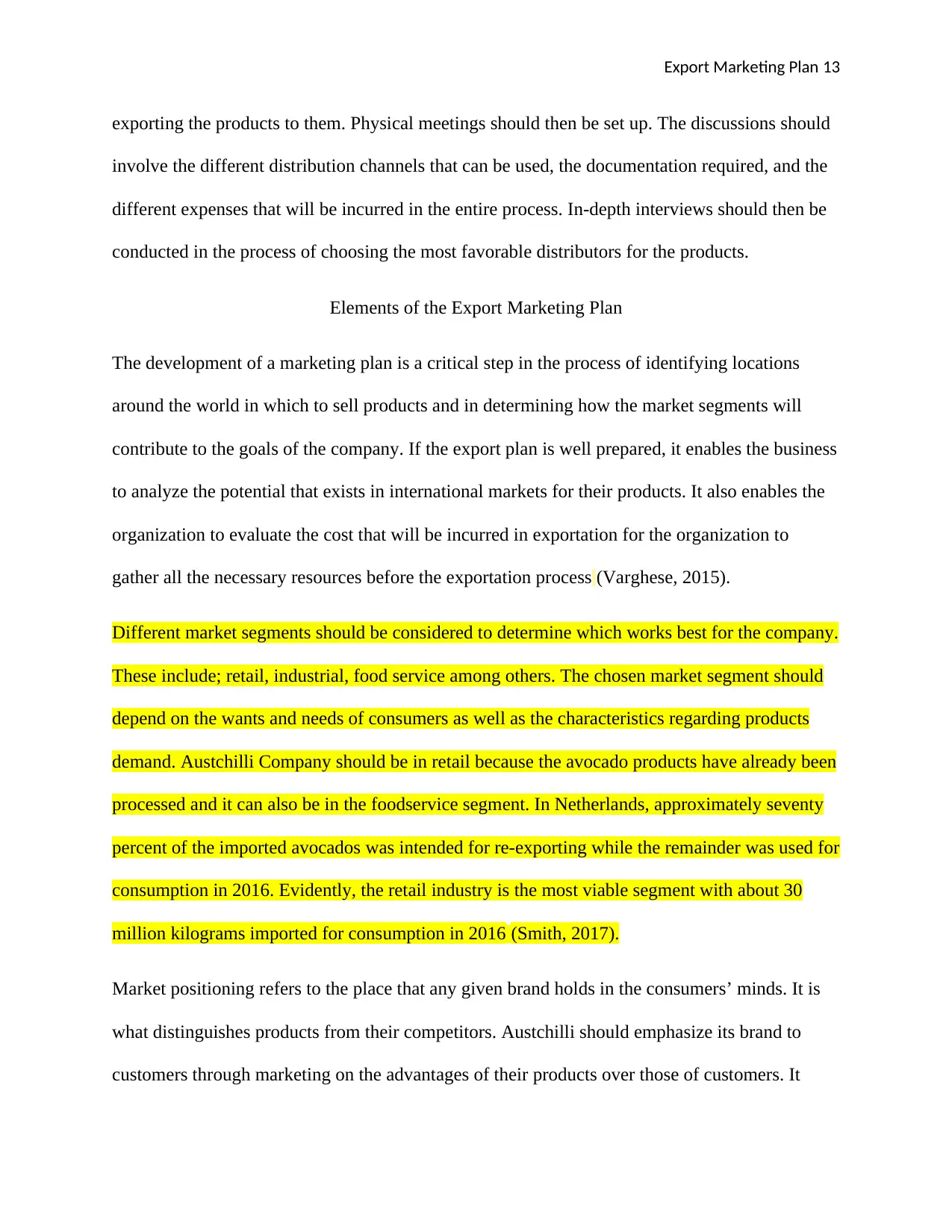
Export Marketing Plan 13
exporting the products to them. Physical meetings should then be set up. The discussions should
involve the different distribution channels that can be used, the documentation required, and the
different expenses that will be incurred in the entire process. In-depth interviews should then be
conducted in the process of choosing the most favorable distributors for the products.
Elements of the Export Marketing Plan
The development of a marketing plan is a critical step in the process of identifying locations
around the world in which to sell products and in determining how the market segments will
contribute to the goals of the company. If the export plan is well prepared, it enables the business
to analyze the potential that exists in international markets for their products. It also enables the
organization to evaluate the cost that will be incurred in exportation for the organization to
gather all the necessary resources before the exportation process (Varghese, 2015).
Different market segments should be considered to determine which works best for the company.
These include; retail, industrial, food service among others. The chosen market segment should
depend on the wants and needs of consumers as well as the characteristics regarding products
demand. Austchilli Company should be in retail because the avocado products have already been
processed and it can also be in the foodservice segment. In Netherlands, approximately seventy
percent of the imported avocados was intended for re-exporting while the remainder was used for
consumption in 2016. Evidently, the retail industry is the most viable segment with about 30
million kilograms imported for consumption in 2016 (Smith, 2017).
Market positioning refers to the place that any given brand holds in the consumers’ minds. It is
what distinguishes products from their competitors. Austchilli should emphasize its brand to
customers through marketing on the advantages of their products over those of customers. It
exporting the products to them. Physical meetings should then be set up. The discussions should
involve the different distribution channels that can be used, the documentation required, and the
different expenses that will be incurred in the entire process. In-depth interviews should then be
conducted in the process of choosing the most favorable distributors for the products.
Elements of the Export Marketing Plan
The development of a marketing plan is a critical step in the process of identifying locations
around the world in which to sell products and in determining how the market segments will
contribute to the goals of the company. If the export plan is well prepared, it enables the business
to analyze the potential that exists in international markets for their products. It also enables the
organization to evaluate the cost that will be incurred in exportation for the organization to
gather all the necessary resources before the exportation process (Varghese, 2015).
Different market segments should be considered to determine which works best for the company.
These include; retail, industrial, food service among others. The chosen market segment should
depend on the wants and needs of consumers as well as the characteristics regarding products
demand. Austchilli Company should be in retail because the avocado products have already been
processed and it can also be in the foodservice segment. In Netherlands, approximately seventy
percent of the imported avocados was intended for re-exporting while the remainder was used for
consumption in 2016. Evidently, the retail industry is the most viable segment with about 30
million kilograms imported for consumption in 2016 (Smith, 2017).
Market positioning refers to the place that any given brand holds in the consumers’ minds. It is
what distinguishes products from their competitors. Austchilli should emphasize its brand to
customers through marketing on the advantages of their products over those of customers. It
Paraphrase This Document
Need a fresh take? Get an instant paraphrase of this document with our AI Paraphraser
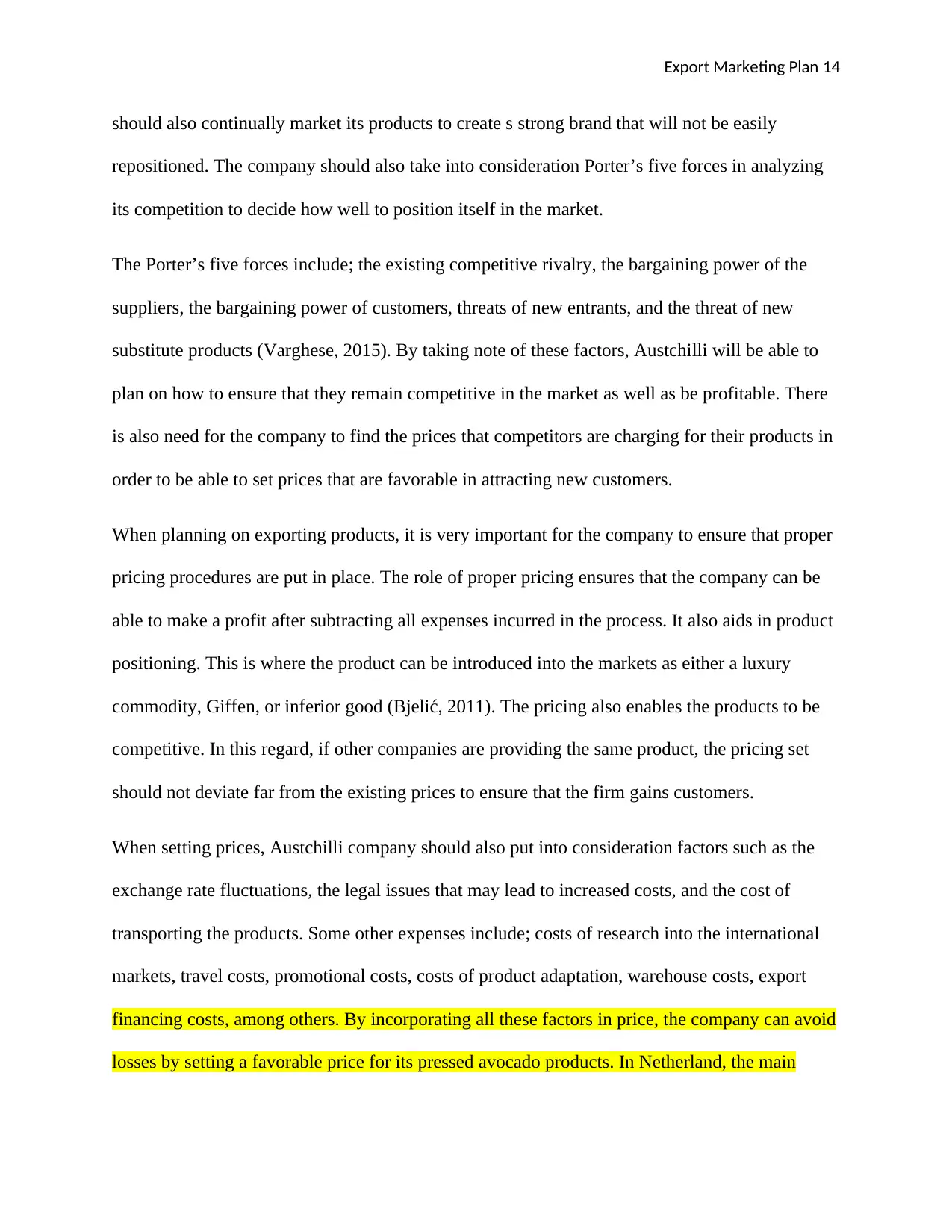
Export Marketing Plan 14
should also continually market its products to create s strong brand that will not be easily
repositioned. The company should also take into consideration Porter’s five forces in analyzing
its competition to decide how well to position itself in the market.
The Porter’s five forces include; the existing competitive rivalry, the bargaining power of the
suppliers, the bargaining power of customers, threats of new entrants, and the threat of new
substitute products (Varghese, 2015). By taking note of these factors, Austchilli will be able to
plan on how to ensure that they remain competitive in the market as well as be profitable. There
is also need for the company to find the prices that competitors are charging for their products in
order to be able to set prices that are favorable in attracting new customers.
When planning on exporting products, it is very important for the company to ensure that proper
pricing procedures are put in place. The role of proper pricing ensures that the company can be
able to make a profit after subtracting all expenses incurred in the process. It also aids in product
positioning. This is where the product can be introduced into the markets as either a luxury
commodity, Giffen, or inferior good (Bjelić, 2011). The pricing also enables the products to be
competitive. In this regard, if other companies are providing the same product, the pricing set
should not deviate far from the existing prices to ensure that the firm gains customers.
When setting prices, Austchilli company should also put into consideration factors such as the
exchange rate fluctuations, the legal issues that may lead to increased costs, and the cost of
transporting the products. Some other expenses include; costs of research into the international
markets, travel costs, promotional costs, costs of product adaptation, warehouse costs, export
financing costs, among others. By incorporating all these factors in price, the company can avoid
losses by setting a favorable price for its pressed avocado products. In Netherland, the main
should also continually market its products to create s strong brand that will not be easily
repositioned. The company should also take into consideration Porter’s five forces in analyzing
its competition to decide how well to position itself in the market.
The Porter’s five forces include; the existing competitive rivalry, the bargaining power of the
suppliers, the bargaining power of customers, threats of new entrants, and the threat of new
substitute products (Varghese, 2015). By taking note of these factors, Austchilli will be able to
plan on how to ensure that they remain competitive in the market as well as be profitable. There
is also need for the company to find the prices that competitors are charging for their products in
order to be able to set prices that are favorable in attracting new customers.
When planning on exporting products, it is very important for the company to ensure that proper
pricing procedures are put in place. The role of proper pricing ensures that the company can be
able to make a profit after subtracting all expenses incurred in the process. It also aids in product
positioning. This is where the product can be introduced into the markets as either a luxury
commodity, Giffen, or inferior good (Bjelić, 2011). The pricing also enables the products to be
competitive. In this regard, if other companies are providing the same product, the pricing set
should not deviate far from the existing prices to ensure that the firm gains customers.
When setting prices, Austchilli company should also put into consideration factors such as the
exchange rate fluctuations, the legal issues that may lead to increased costs, and the cost of
transporting the products. Some other expenses include; costs of research into the international
markets, travel costs, promotional costs, costs of product adaptation, warehouse costs, export
financing costs, among others. By incorporating all these factors in price, the company can avoid
losses by setting a favorable price for its pressed avocado products. In Netherland, the main
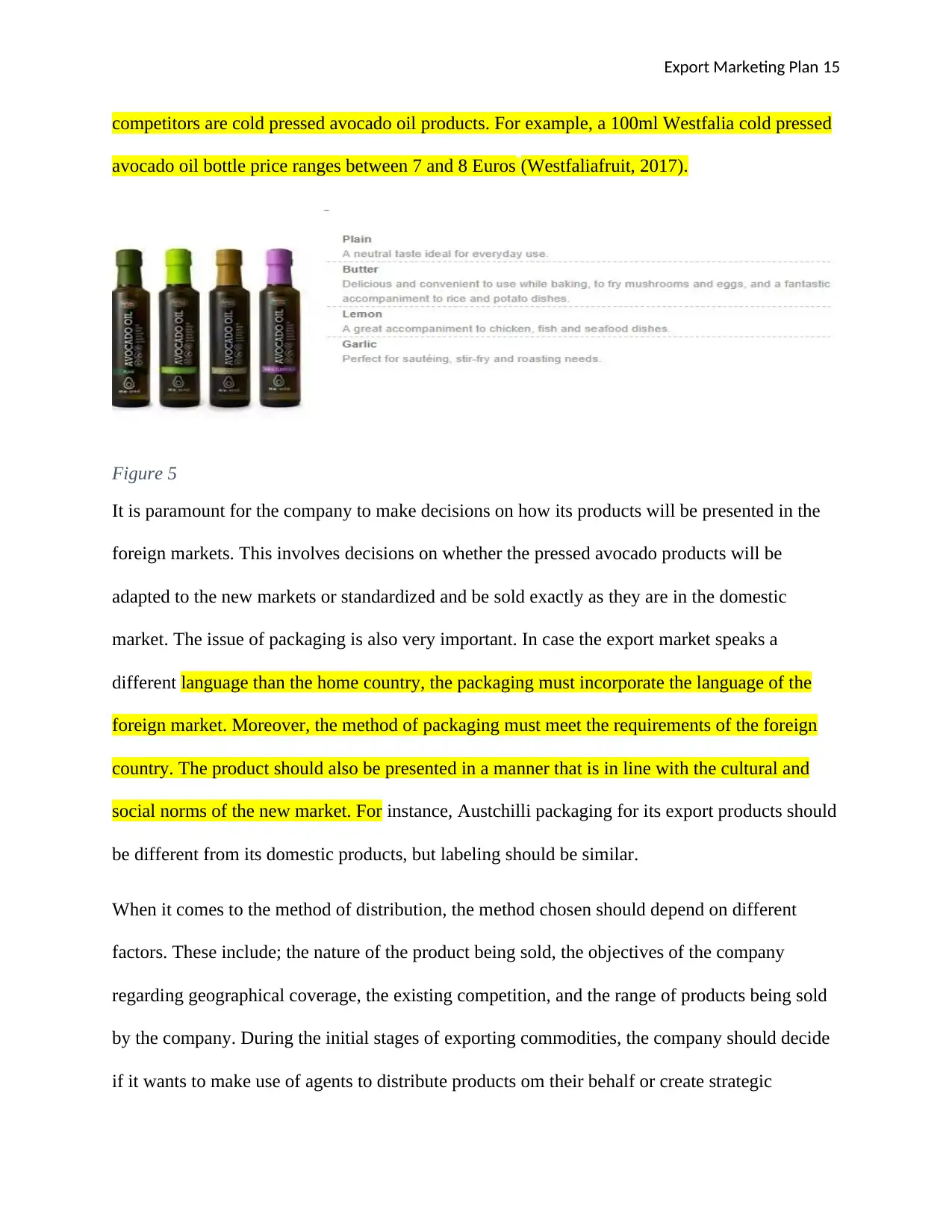
Export Marketing Plan 15
competitors are cold pressed avocado oil products. For example, a 100ml Westfalia cold pressed
avocado oil bottle price ranges between 7 and 8 Euros (Westfaliafruit, 2017).
Figure 5
It is paramount for the company to make decisions on how its products will be presented in the
foreign markets. This involves decisions on whether the pressed avocado products will be
adapted to the new markets or standardized and be sold exactly as they are in the domestic
market. The issue of packaging is also very important. In case the export market speaks a
different language than the home country, the packaging must incorporate the language of the
foreign market. Moreover, the method of packaging must meet the requirements of the foreign
country. The product should also be presented in a manner that is in line with the cultural and
social norms of the new market. For instance, Austchilli packaging for its export products should
be different from its domestic products, but labeling should be similar.
When it comes to the method of distribution, the method chosen should depend on different
factors. These include; the nature of the product being sold, the objectives of the company
regarding geographical coverage, the existing competition, and the range of products being sold
by the company. During the initial stages of exporting commodities, the company should decide
if it wants to make use of agents to distribute products om their behalf or create strategic
competitors are cold pressed avocado oil products. For example, a 100ml Westfalia cold pressed
avocado oil bottle price ranges between 7 and 8 Euros (Westfaliafruit, 2017).
Figure 5
It is paramount for the company to make decisions on how its products will be presented in the
foreign markets. This involves decisions on whether the pressed avocado products will be
adapted to the new markets or standardized and be sold exactly as they are in the domestic
market. The issue of packaging is also very important. In case the export market speaks a
different language than the home country, the packaging must incorporate the language of the
foreign market. Moreover, the method of packaging must meet the requirements of the foreign
country. The product should also be presented in a manner that is in line with the cultural and
social norms of the new market. For instance, Austchilli packaging for its export products should
be different from its domestic products, but labeling should be similar.
When it comes to the method of distribution, the method chosen should depend on different
factors. These include; the nature of the product being sold, the objectives of the company
regarding geographical coverage, the existing competition, and the range of products being sold
by the company. During the initial stages of exporting commodities, the company should decide
if it wants to make use of agents to distribute products om their behalf or create strategic
You're viewing a preview
Unlock full access by subscribing today!
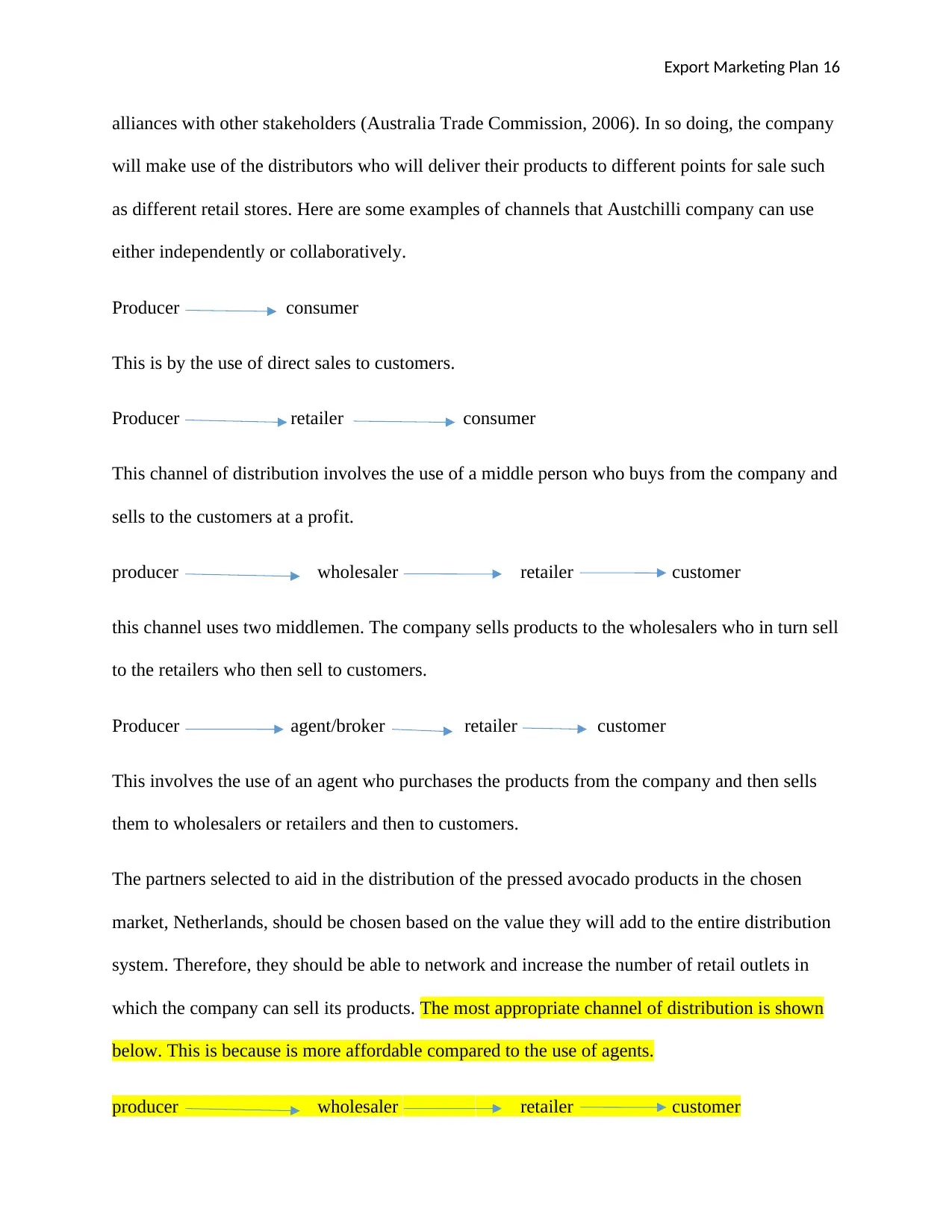
Export Marketing Plan 16
alliances with other stakeholders (Australia Trade Commission, 2006). In so doing, the company
will make use of the distributors who will deliver their products to different points for sale such
as different retail stores. Here are some examples of channels that Austchilli company can use
either independently or collaboratively.
Producer consumer
This is by the use of direct sales to customers.
Producer retailer consumer
This channel of distribution involves the use of a middle person who buys from the company and
sells to the customers at a profit.
producer wholesaler retailer customer
this channel uses two middlemen. The company sells products to the wholesalers who in turn sell
to the retailers who then sell to customers.
Producer agent/broker retailer customer
This involves the use of an agent who purchases the products from the company and then sells
them to wholesalers or retailers and then to customers.
The partners selected to aid in the distribution of the pressed avocado products in the chosen
market, Netherlands, should be chosen based on the value they will add to the entire distribution
system. Therefore, they should be able to network and increase the number of retail outlets in
which the company can sell its products. The most appropriate channel of distribution is shown
below. This is because is more affordable compared to the use of agents.
producer wholesaler retailer customer
alliances with other stakeholders (Australia Trade Commission, 2006). In so doing, the company
will make use of the distributors who will deliver their products to different points for sale such
as different retail stores. Here are some examples of channels that Austchilli company can use
either independently or collaboratively.
Producer consumer
This is by the use of direct sales to customers.
Producer retailer consumer
This channel of distribution involves the use of a middle person who buys from the company and
sells to the customers at a profit.
producer wholesaler retailer customer
this channel uses two middlemen. The company sells products to the wholesalers who in turn sell
to the retailers who then sell to customers.
Producer agent/broker retailer customer
This involves the use of an agent who purchases the products from the company and then sells
them to wholesalers or retailers and then to customers.
The partners selected to aid in the distribution of the pressed avocado products in the chosen
market, Netherlands, should be chosen based on the value they will add to the entire distribution
system. Therefore, they should be able to network and increase the number of retail outlets in
which the company can sell its products. The most appropriate channel of distribution is shown
below. This is because is more affordable compared to the use of agents.
producer wholesaler retailer customer
Paraphrase This Document
Need a fresh take? Get an instant paraphrase of this document with our AI Paraphraser
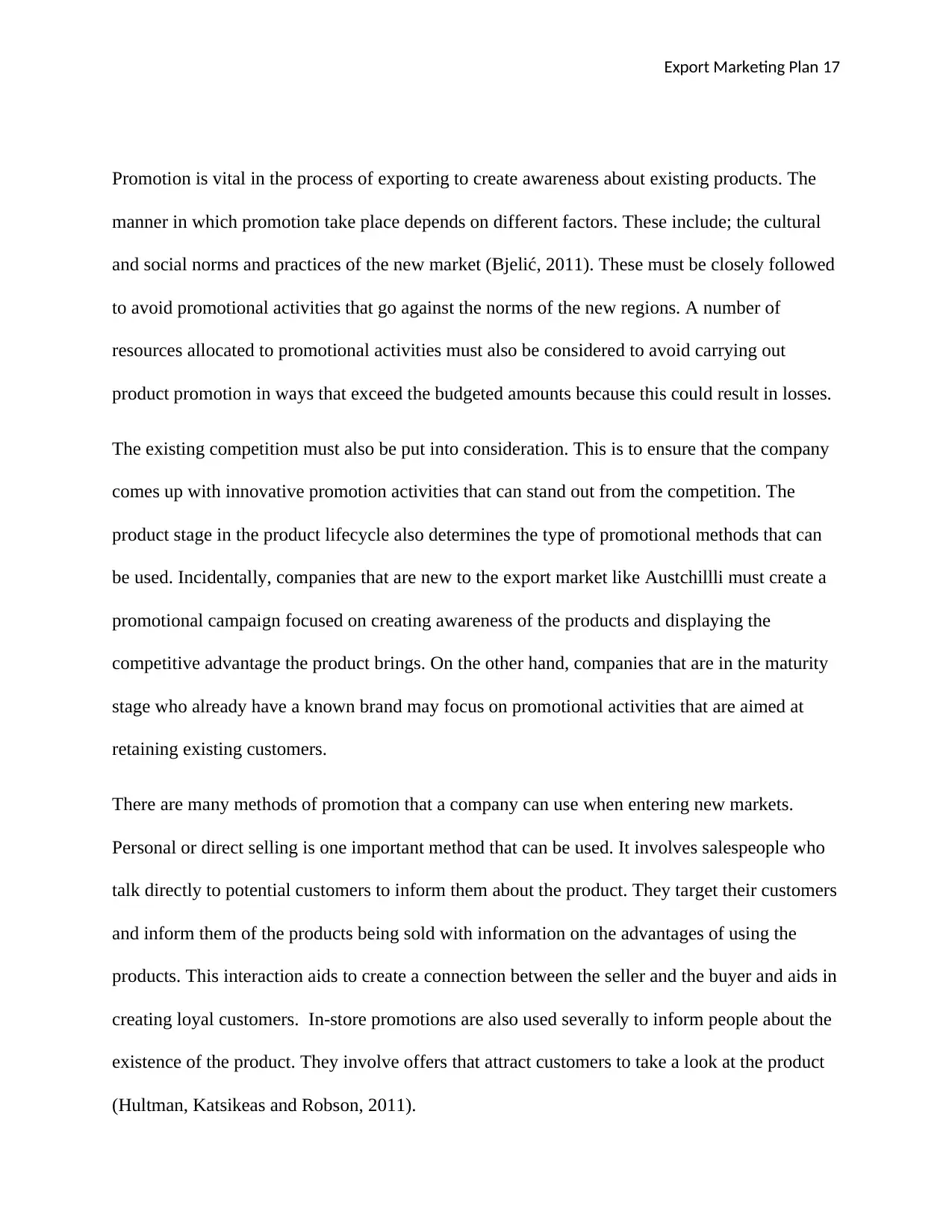
Export Marketing Plan 17
Promotion is vital in the process of exporting to create awareness about existing products. The
manner in which promotion take place depends on different factors. These include; the cultural
and social norms and practices of the new market (Bjelić, 2011). These must be closely followed
to avoid promotional activities that go against the norms of the new regions. A number of
resources allocated to promotional activities must also be considered to avoid carrying out
product promotion in ways that exceed the budgeted amounts because this could result in losses.
The existing competition must also be put into consideration. This is to ensure that the company
comes up with innovative promotion activities that can stand out from the competition. The
product stage in the product lifecycle also determines the type of promotional methods that can
be used. Incidentally, companies that are new to the export market like Austchillli must create a
promotional campaign focused on creating awareness of the products and displaying the
competitive advantage the product brings. On the other hand, companies that are in the maturity
stage who already have a known brand may focus on promotional activities that are aimed at
retaining existing customers.
There are many methods of promotion that a company can use when entering new markets.
Personal or direct selling is one important method that can be used. It involves salespeople who
talk directly to potential customers to inform them about the product. They target their customers
and inform them of the products being sold with information on the advantages of using the
products. This interaction aids to create a connection between the seller and the buyer and aids in
creating loyal customers. In-store promotions are also used severally to inform people about the
existence of the product. They involve offers that attract customers to take a look at the product
(Hultman, Katsikeas and Robson, 2011).
Promotion is vital in the process of exporting to create awareness about existing products. The
manner in which promotion take place depends on different factors. These include; the cultural
and social norms and practices of the new market (Bjelić, 2011). These must be closely followed
to avoid promotional activities that go against the norms of the new regions. A number of
resources allocated to promotional activities must also be considered to avoid carrying out
product promotion in ways that exceed the budgeted amounts because this could result in losses.
The existing competition must also be put into consideration. This is to ensure that the company
comes up with innovative promotion activities that can stand out from the competition. The
product stage in the product lifecycle also determines the type of promotional methods that can
be used. Incidentally, companies that are new to the export market like Austchillli must create a
promotional campaign focused on creating awareness of the products and displaying the
competitive advantage the product brings. On the other hand, companies that are in the maturity
stage who already have a known brand may focus on promotional activities that are aimed at
retaining existing customers.
There are many methods of promotion that a company can use when entering new markets.
Personal or direct selling is one important method that can be used. It involves salespeople who
talk directly to potential customers to inform them about the product. They target their customers
and inform them of the products being sold with information on the advantages of using the
products. This interaction aids to create a connection between the seller and the buyer and aids in
creating loyal customers. In-store promotions are also used severally to inform people about the
existence of the product. They involve offers that attract customers to take a look at the product
(Hultman, Katsikeas and Robson, 2011).
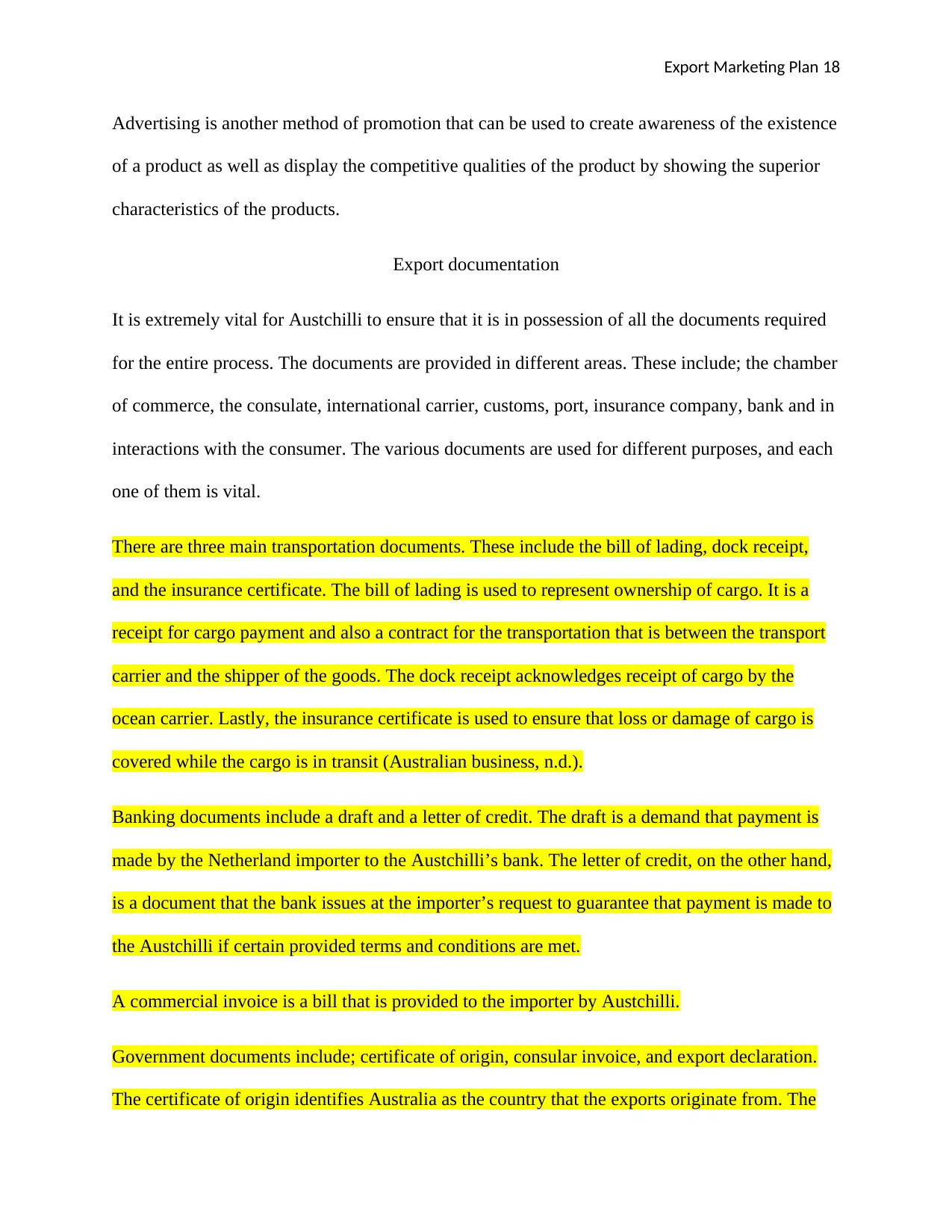
Export Marketing Plan 18
Advertising is another method of promotion that can be used to create awareness of the existence
of a product as well as display the competitive qualities of the product by showing the superior
characteristics of the products.
Export documentation
It is extremely vital for Austchilli to ensure that it is in possession of all the documents required
for the entire process. The documents are provided in different areas. These include; the chamber
of commerce, the consulate, international carrier, customs, port, insurance company, bank and in
interactions with the consumer. The various documents are used for different purposes, and each
one of them is vital.
There are three main transportation documents. These include the bill of lading, dock receipt,
and the insurance certificate. The bill of lading is used to represent ownership of cargo. It is a
receipt for cargo payment and also a contract for the transportation that is between the transport
carrier and the shipper of the goods. The dock receipt acknowledges receipt of cargo by the
ocean carrier. Lastly, the insurance certificate is used to ensure that loss or damage of cargo is
covered while the cargo is in transit (Australian business, n.d.).
Banking documents include a draft and a letter of credit. The draft is a demand that payment is
made by the Netherland importer to the Austchilli’s bank. The letter of credit, on the other hand,
is a document that the bank issues at the importer’s request to guarantee that payment is made to
the Austchilli if certain provided terms and conditions are met.
A commercial invoice is a bill that is provided to the importer by Austchilli.
Government documents include; certificate of origin, consular invoice, and export declaration.
The certificate of origin identifies Australia as the country that the exports originate from. The
Advertising is another method of promotion that can be used to create awareness of the existence
of a product as well as display the competitive qualities of the product by showing the superior
characteristics of the products.
Export documentation
It is extremely vital for Austchilli to ensure that it is in possession of all the documents required
for the entire process. The documents are provided in different areas. These include; the chamber
of commerce, the consulate, international carrier, customs, port, insurance company, bank and in
interactions with the consumer. The various documents are used for different purposes, and each
one of them is vital.
There are three main transportation documents. These include the bill of lading, dock receipt,
and the insurance certificate. The bill of lading is used to represent ownership of cargo. It is a
receipt for cargo payment and also a contract for the transportation that is between the transport
carrier and the shipper of the goods. The dock receipt acknowledges receipt of cargo by the
ocean carrier. Lastly, the insurance certificate is used to ensure that loss or damage of cargo is
covered while the cargo is in transit (Australian business, n.d.).
Banking documents include a draft and a letter of credit. The draft is a demand that payment is
made by the Netherland importer to the Austchilli’s bank. The letter of credit, on the other hand,
is a document that the bank issues at the importer’s request to guarantee that payment is made to
the Austchilli if certain provided terms and conditions are met.
A commercial invoice is a bill that is provided to the importer by Austchilli.
Government documents include; certificate of origin, consular invoice, and export declaration.
The certificate of origin identifies Australia as the country that the exports originate from. The
You're viewing a preview
Unlock full access by subscribing today!

Export Marketing Plan 19
consular invoice is a document signed by the consul of Netherland to aid in the control and
identification of goods that are being shipped into that Netherland. Finally, the export declaration
is a document that provides complete information regarding the shipment (Australia Trade and
Investment Commission, n.d.).
Risks and how they can be mitigated.
The exportation process is risky for a myriad of reasons. The process of exporting products
requires substantial amounts of capital. This capital is used to cover the different expenses
incurred during the exportation process. The orders that are exported may also require adaptation
in a bid to fit the new markets. These processes may involve repackaging of the products to fit
the specifications of the foreign markets. These are regarding language used on the packaging, or
production of the product in a new way that is totally different from the inventory demanded in
the domestic markets such as cold pressed avocado oils (Linda, 2011). This is risky because in
case the products do not sell as expected in the Netherland, it could be difficult to bring them
back and find a market for them locally. This can be mitigated by ensuring thorough research is
carried out to reduce the probability of losses occurring (New Zealand Trade and Enterprise,
n.d.).
Another risk that is faced in exporting products is that it may prove hard to pursue customers in
legal processes. This is mainly due to geographical disparity and the difference in legal systems
in both countries. Additionally, the differences that exist in cultural and social practices, as well
as language may confuse the interactions between the Australian workers and clients in the
Netherland. There could also be disagreements between the two parties on various issues such as
consular invoice is a document signed by the consul of Netherland to aid in the control and
identification of goods that are being shipped into that Netherland. Finally, the export declaration
is a document that provides complete information regarding the shipment (Australia Trade and
Investment Commission, n.d.).
Risks and how they can be mitigated.
The exportation process is risky for a myriad of reasons. The process of exporting products
requires substantial amounts of capital. This capital is used to cover the different expenses
incurred during the exportation process. The orders that are exported may also require adaptation
in a bid to fit the new markets. These processes may involve repackaging of the products to fit
the specifications of the foreign markets. These are regarding language used on the packaging, or
production of the product in a new way that is totally different from the inventory demanded in
the domestic markets such as cold pressed avocado oils (Linda, 2011). This is risky because in
case the products do not sell as expected in the Netherland, it could be difficult to bring them
back and find a market for them locally. This can be mitigated by ensuring thorough research is
carried out to reduce the probability of losses occurring (New Zealand Trade and Enterprise,
n.d.).
Another risk that is faced in exporting products is that it may prove hard to pursue customers in
legal processes. This is mainly due to geographical disparity and the difference in legal systems
in both countries. Additionally, the differences that exist in cultural and social practices, as well
as language may confuse the interactions between the Australian workers and clients in the
Netherland. There could also be disagreements between the two parties on various issues such as
Paraphrase This Document
Need a fresh take? Get an instant paraphrase of this document with our AI Paraphraser
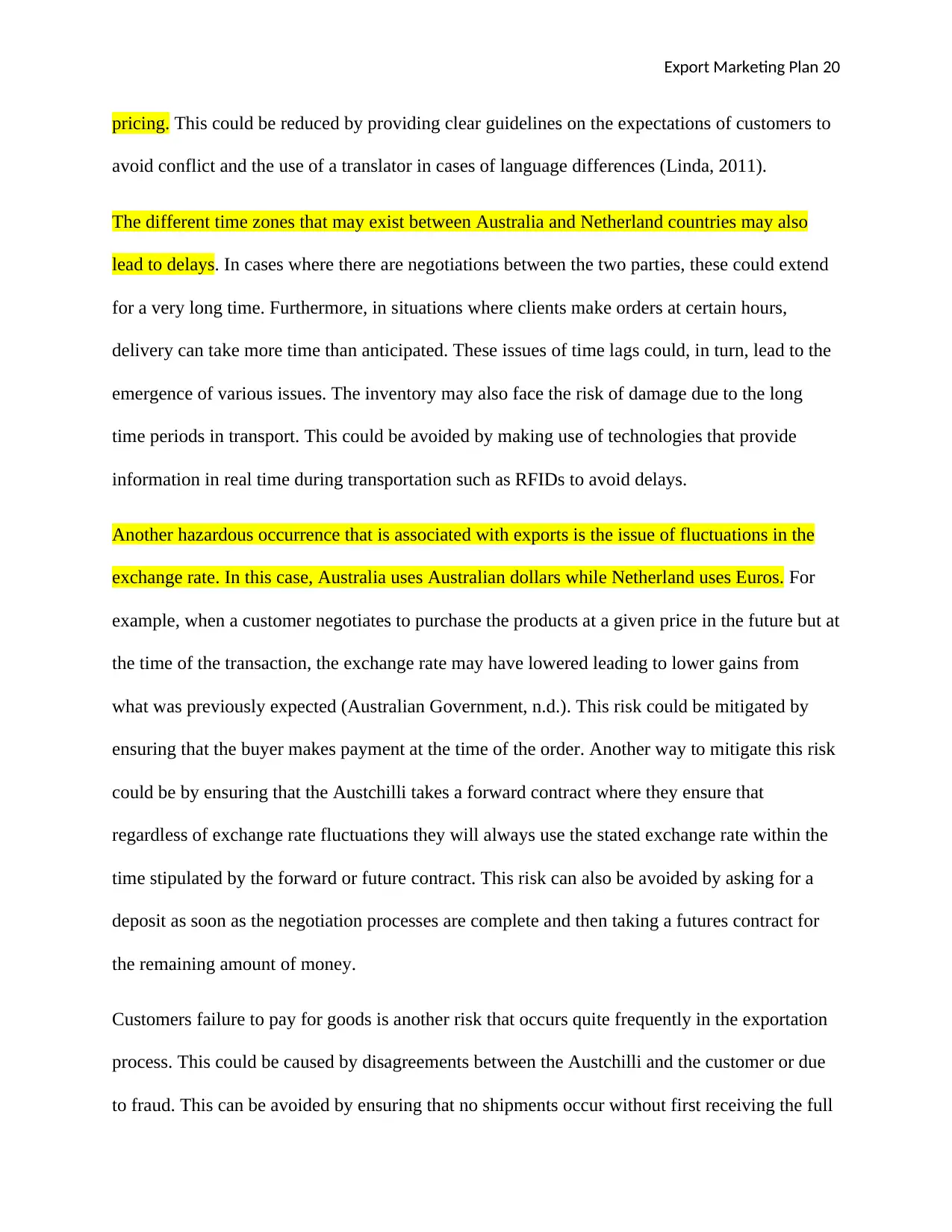
Export Marketing Plan 20
pricing. This could be reduced by providing clear guidelines on the expectations of customers to
avoid conflict and the use of a translator in cases of language differences (Linda, 2011).
The different time zones that may exist between Australia and Netherland countries may also
lead to delays. In cases where there are negotiations between the two parties, these could extend
for a very long time. Furthermore, in situations where clients make orders at certain hours,
delivery can take more time than anticipated. These issues of time lags could, in turn, lead to the
emergence of various issues. The inventory may also face the risk of damage due to the long
time periods in transport. This could be avoided by making use of technologies that provide
information in real time during transportation such as RFIDs to avoid delays.
Another hazardous occurrence that is associated with exports is the issue of fluctuations in the
exchange rate. In this case, Australia uses Australian dollars while Netherland uses Euros. For
example, when a customer negotiates to purchase the products at a given price in the future but at
the time of the transaction, the exchange rate may have lowered leading to lower gains from
what was previously expected (Australian Government, n.d.). This risk could be mitigated by
ensuring that the buyer makes payment at the time of the order. Another way to mitigate this risk
could be by ensuring that the Austchilli takes a forward contract where they ensure that
regardless of exchange rate fluctuations they will always use the stated exchange rate within the
time stipulated by the forward or future contract. This risk can also be avoided by asking for a
deposit as soon as the negotiation processes are complete and then taking a futures contract for
the remaining amount of money.
Customers failure to pay for goods is another risk that occurs quite frequently in the exportation
process. This could be caused by disagreements between the Austchilli and the customer or due
to fraud. This can be avoided by ensuring that no shipments occur without first receiving the full
pricing. This could be reduced by providing clear guidelines on the expectations of customers to
avoid conflict and the use of a translator in cases of language differences (Linda, 2011).
The different time zones that may exist between Australia and Netherland countries may also
lead to delays. In cases where there are negotiations between the two parties, these could extend
for a very long time. Furthermore, in situations where clients make orders at certain hours,
delivery can take more time than anticipated. These issues of time lags could, in turn, lead to the
emergence of various issues. The inventory may also face the risk of damage due to the long
time periods in transport. This could be avoided by making use of technologies that provide
information in real time during transportation such as RFIDs to avoid delays.
Another hazardous occurrence that is associated with exports is the issue of fluctuations in the
exchange rate. In this case, Australia uses Australian dollars while Netherland uses Euros. For
example, when a customer negotiates to purchase the products at a given price in the future but at
the time of the transaction, the exchange rate may have lowered leading to lower gains from
what was previously expected (Australian Government, n.d.). This risk could be mitigated by
ensuring that the buyer makes payment at the time of the order. Another way to mitigate this risk
could be by ensuring that the Austchilli takes a forward contract where they ensure that
regardless of exchange rate fluctuations they will always use the stated exchange rate within the
time stipulated by the forward or future contract. This risk can also be avoided by asking for a
deposit as soon as the negotiation processes are complete and then taking a futures contract for
the remaining amount of money.
Customers failure to pay for goods is another risk that occurs quite frequently in the exportation
process. This could be caused by disagreements between the Austchilli and the customer or due
to fraud. This can be avoided by ensuring that no shipments occur without first receiving the full
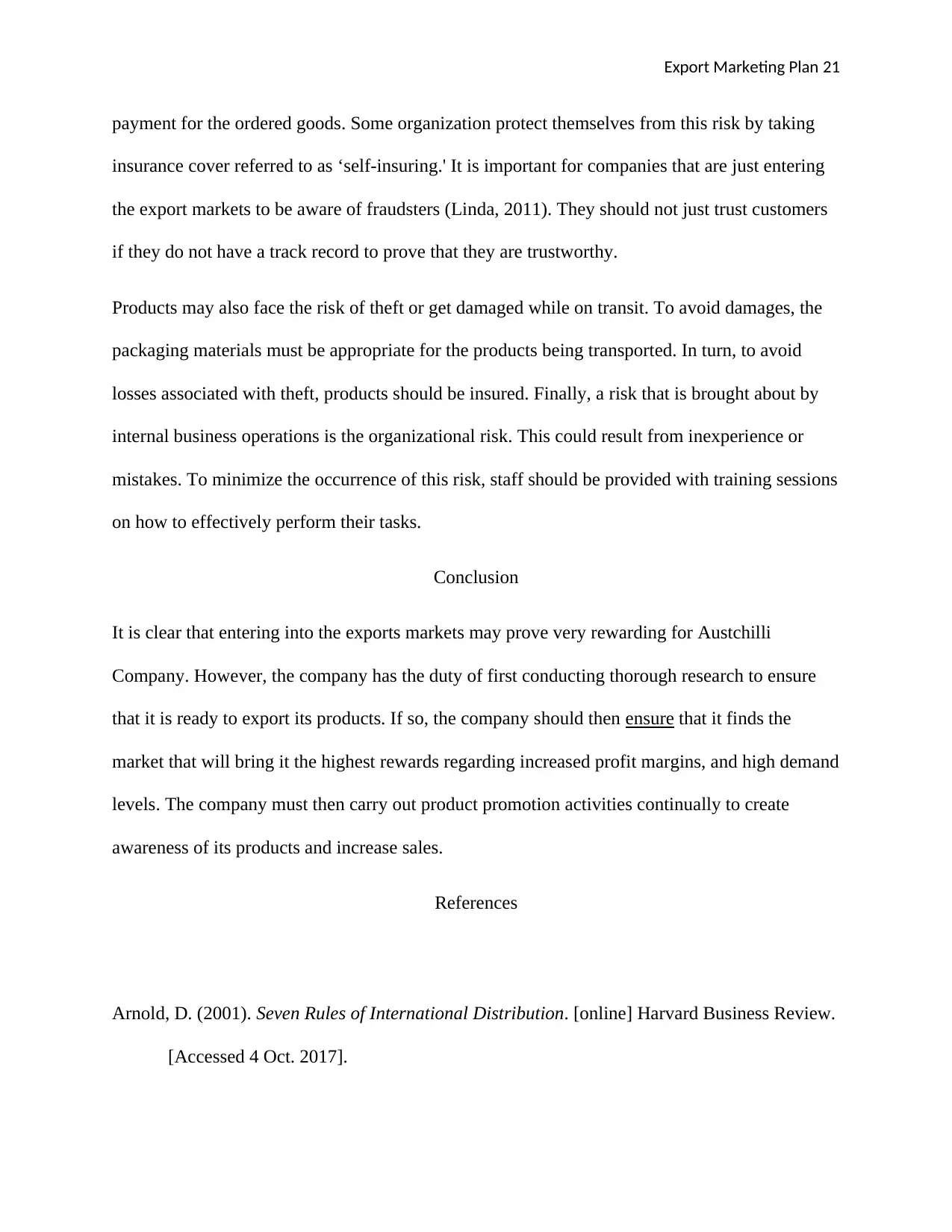
Export Marketing Plan 21
payment for the ordered goods. Some organization protect themselves from this risk by taking
insurance cover referred to as ‘self-insuring.' It is important for companies that are just entering
the export markets to be aware of fraudsters (Linda, 2011). They should not just trust customers
if they do not have a track record to prove that they are trustworthy.
Products may also face the risk of theft or get damaged while on transit. To avoid damages, the
packaging materials must be appropriate for the products being transported. In turn, to avoid
losses associated with theft, products should be insured. Finally, a risk that is brought about by
internal business operations is the organizational risk. This could result from inexperience or
mistakes. To minimize the occurrence of this risk, staff should be provided with training sessions
on how to effectively perform their tasks.
Conclusion
It is clear that entering into the exports markets may prove very rewarding for Austchilli
Company. However, the company has the duty of first conducting thorough research to ensure
that it is ready to export its products. If so, the company should then ensure that it finds the
market that will bring it the highest rewards regarding increased profit margins, and high demand
levels. The company must then carry out product promotion activities continually to create
awareness of its products and increase sales.
References
Arnold, D. (2001). Seven Rules of International Distribution. [online] Harvard Business Review.
[Accessed 4 Oct. 2017].
payment for the ordered goods. Some organization protect themselves from this risk by taking
insurance cover referred to as ‘self-insuring.' It is important for companies that are just entering
the export markets to be aware of fraudsters (Linda, 2011). They should not just trust customers
if they do not have a track record to prove that they are trustworthy.
Products may also face the risk of theft or get damaged while on transit. To avoid damages, the
packaging materials must be appropriate for the products being transported. In turn, to avoid
losses associated with theft, products should be insured. Finally, a risk that is brought about by
internal business operations is the organizational risk. This could result from inexperience or
mistakes. To minimize the occurrence of this risk, staff should be provided with training sessions
on how to effectively perform their tasks.
Conclusion
It is clear that entering into the exports markets may prove very rewarding for Austchilli
Company. However, the company has the duty of first conducting thorough research to ensure
that it is ready to export its products. If so, the company should then ensure that it finds the
market that will bring it the highest rewards regarding increased profit margins, and high demand
levels. The company must then carry out product promotion activities continually to create
awareness of its products and increase sales.
References
Arnold, D. (2001). Seven Rules of International Distribution. [online] Harvard Business Review.
[Accessed 4 Oct. 2017].
You're viewing a preview
Unlock full access by subscribing today!
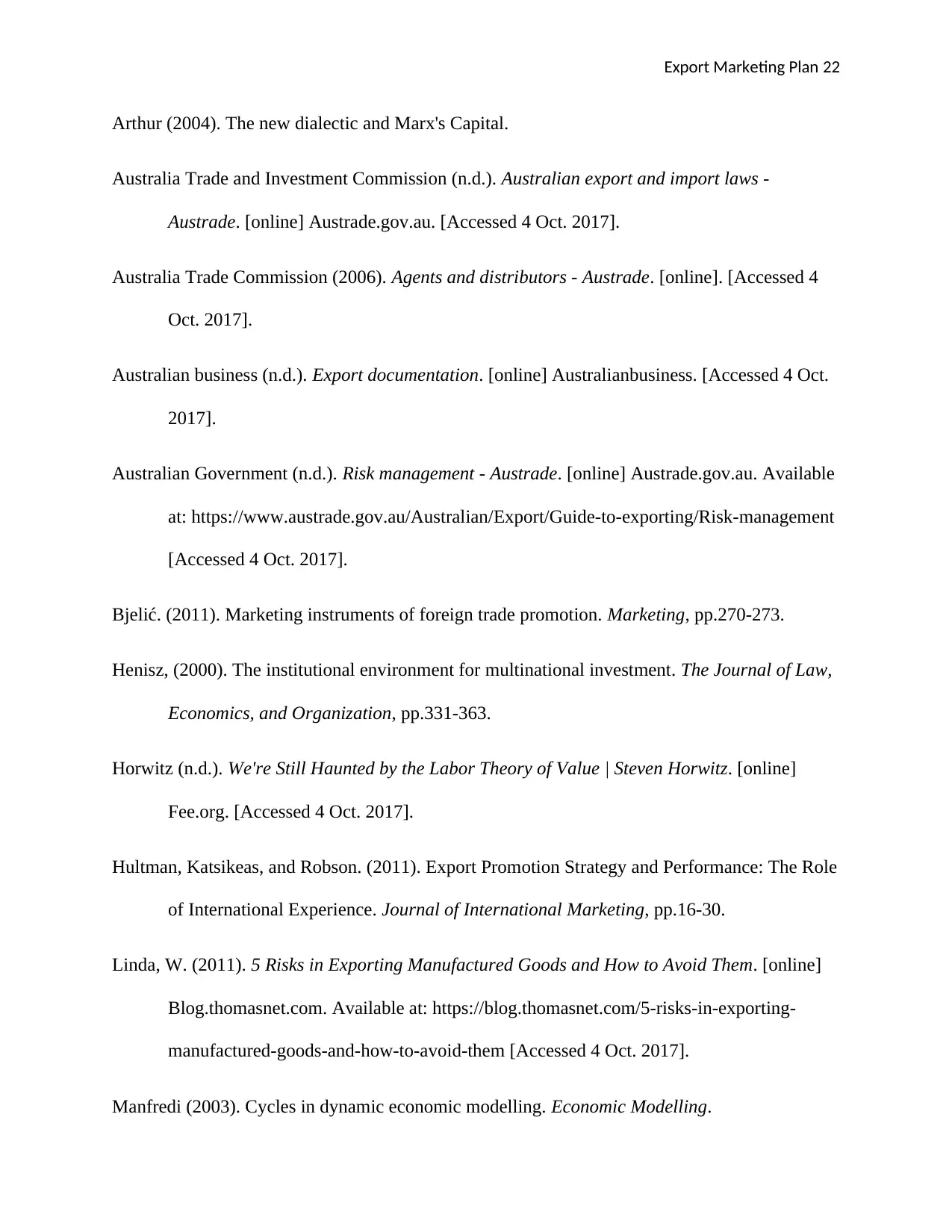
Export Marketing Plan 22
Arthur (2004). The new dialectic and Marx's Capital.
Australia Trade and Investment Commission (n.d.). Australian export and import laws -
Austrade. [online] Austrade.gov.au. [Accessed 4 Oct. 2017].
Australia Trade Commission (2006). Agents and distributors - Austrade. [online]. [Accessed 4
Oct. 2017].
Australian business (n.d.). Export documentation. [online] Australianbusiness. [Accessed 4 Oct.
2017].
Australian Government (n.d.). Risk management - Austrade. [online] Austrade.gov.au. Available
at: https://www.austrade.gov.au/Australian/Export/Guide-to-exporting/Risk-management
[Accessed 4 Oct. 2017].
Bjelić. (2011). Marketing instruments of foreign trade promotion. Marketing, pp.270-273.
Henisz, (2000). The institutional environment for multinational investment. The Journal of Law,
Economics, and Organization, pp.331-363.
Horwitz (n.d.). We're Still Haunted by the Labor Theory of Value | Steven Horwitz. [online]
Fee.org. [Accessed 4 Oct. 2017].
Hultman, Katsikeas, and Robson. (2011). Export Promotion Strategy and Performance: The Role
of International Experience. Journal of International Marketing, pp.16-30.
Linda, W. (2011). 5 Risks in Exporting Manufactured Goods and How to Avoid Them. [online]
Blog.thomasnet.com. Available at: https://blog.thomasnet.com/5-risks-in-exporting-
manufactured-goods-and-how-to-avoid-them [Accessed 4 Oct. 2017].
Manfredi (2003). Cycles in dynamic economic modelling. Economic Modelling.
Arthur (2004). The new dialectic and Marx's Capital.
Australia Trade and Investment Commission (n.d.). Australian export and import laws -
Austrade. [online] Austrade.gov.au. [Accessed 4 Oct. 2017].
Australia Trade Commission (2006). Agents and distributors - Austrade. [online]. [Accessed 4
Oct. 2017].
Australian business (n.d.). Export documentation. [online] Australianbusiness. [Accessed 4 Oct.
2017].
Australian Government (n.d.). Risk management - Austrade. [online] Austrade.gov.au. Available
at: https://www.austrade.gov.au/Australian/Export/Guide-to-exporting/Risk-management
[Accessed 4 Oct. 2017].
Bjelić. (2011). Marketing instruments of foreign trade promotion. Marketing, pp.270-273.
Henisz, (2000). The institutional environment for multinational investment. The Journal of Law,
Economics, and Organization, pp.331-363.
Horwitz (n.d.). We're Still Haunted by the Labor Theory of Value | Steven Horwitz. [online]
Fee.org. [Accessed 4 Oct. 2017].
Hultman, Katsikeas, and Robson. (2011). Export Promotion Strategy and Performance: The Role
of International Experience. Journal of International Marketing, pp.16-30.
Linda, W. (2011). 5 Risks in Exporting Manufactured Goods and How to Avoid Them. [online]
Blog.thomasnet.com. Available at: https://blog.thomasnet.com/5-risks-in-exporting-
manufactured-goods-and-how-to-avoid-them [Accessed 4 Oct. 2017].
Manfredi (2003). Cycles in dynamic economic modelling. Economic Modelling.
Paraphrase This Document
Need a fresh take? Get an instant paraphrase of this document with our AI Paraphraser
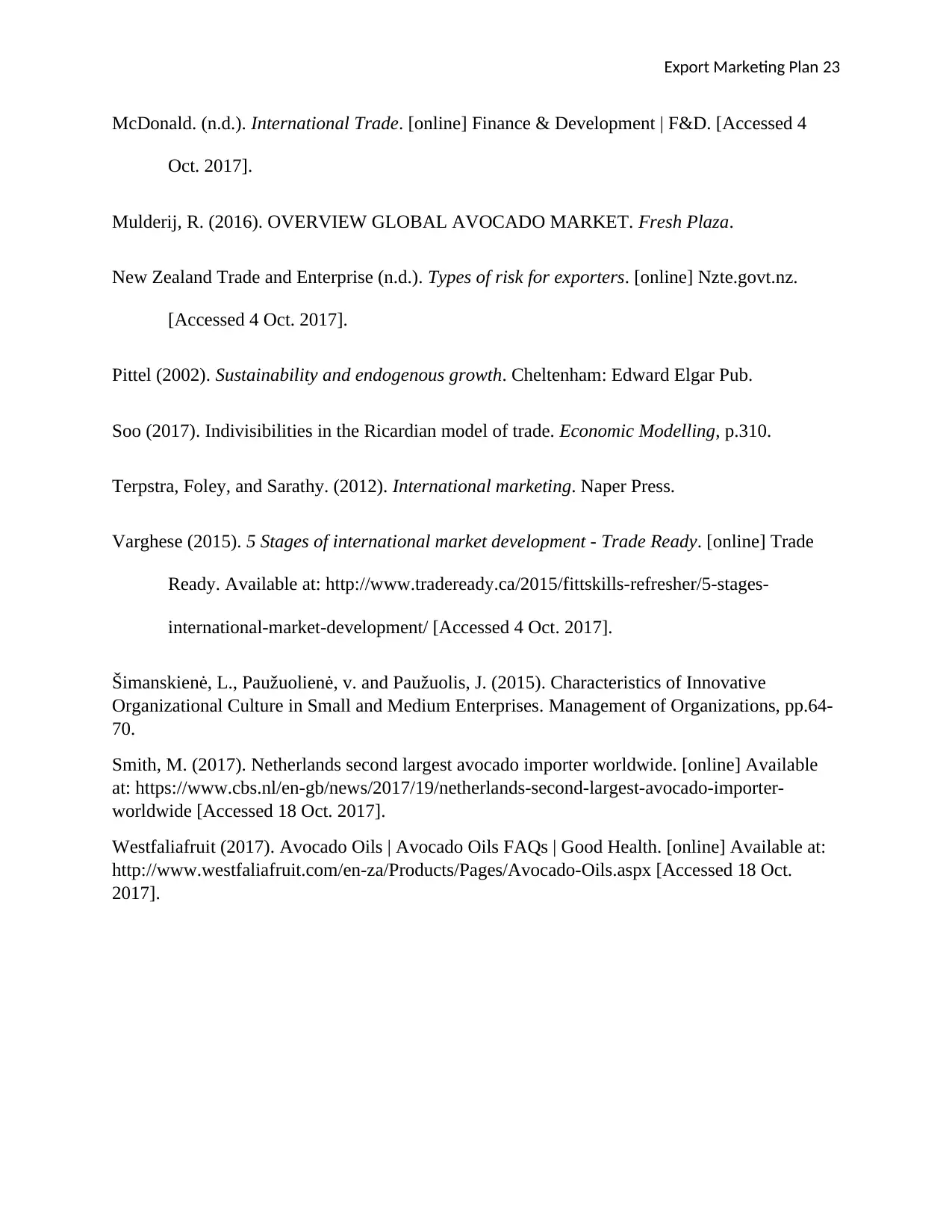
Export Marketing Plan 23
McDonald. (n.d.). International Trade. [online] Finance & Development | F&D. [Accessed 4
Oct. 2017].
Mulderij, R. (2016). OVERVIEW GLOBAL AVOCADO MARKET. Fresh Plaza.
New Zealand Trade and Enterprise (n.d.). Types of risk for exporters. [online] Nzte.govt.nz.
[Accessed 4 Oct. 2017].
Pittel (2002). Sustainability and endogenous growth. Cheltenham: Edward Elgar Pub.
Soo (2017). Indivisibilities in the Ricardian model of trade. Economic Modelling, p.310.
Terpstra, Foley, and Sarathy. (2012). International marketing. Naper Press.
Varghese (2015). 5 Stages of international market development - Trade Ready. [online] Trade
Ready. Available at: http://www.tradeready.ca/2015/fittskills-refresher/5-stages-
international-market-development/ [Accessed 4 Oct. 2017].
Šimanskienė, L., Paužuolienė, v. and Paužuolis, J. (2015). Characteristics of Innovative
Organizational Culture in Small and Medium Enterprises. Management of Organizations, pp.64-
70.
Smith, M. (2017). Netherlands second largest avocado importer worldwide. [online] Available
at: https://www.cbs.nl/en-gb/news/2017/19/netherlands-second-largest-avocado-importer-
worldwide [Accessed 18 Oct. 2017].
Westfaliafruit (2017). Avocado Oils | Avocado Oils FAQs | Good Health. [online] Available at:
http://www.westfaliafruit.com/en-za/Products/Pages/Avocado-Oils.aspx [Accessed 18 Oct.
2017].
McDonald. (n.d.). International Trade. [online] Finance & Development | F&D. [Accessed 4
Oct. 2017].
Mulderij, R. (2016). OVERVIEW GLOBAL AVOCADO MARKET. Fresh Plaza.
New Zealand Trade and Enterprise (n.d.). Types of risk for exporters. [online] Nzte.govt.nz.
[Accessed 4 Oct. 2017].
Pittel (2002). Sustainability and endogenous growth. Cheltenham: Edward Elgar Pub.
Soo (2017). Indivisibilities in the Ricardian model of trade. Economic Modelling, p.310.
Terpstra, Foley, and Sarathy. (2012). International marketing. Naper Press.
Varghese (2015). 5 Stages of international market development - Trade Ready. [online] Trade
Ready. Available at: http://www.tradeready.ca/2015/fittskills-refresher/5-stages-
international-market-development/ [Accessed 4 Oct. 2017].
Šimanskienė, L., Paužuolienė, v. and Paužuolis, J. (2015). Characteristics of Innovative
Organizational Culture in Small and Medium Enterprises. Management of Organizations, pp.64-
70.
Smith, M. (2017). Netherlands second largest avocado importer worldwide. [online] Available
at: https://www.cbs.nl/en-gb/news/2017/19/netherlands-second-largest-avocado-importer-
worldwide [Accessed 18 Oct. 2017].
Westfaliafruit (2017). Avocado Oils | Avocado Oils FAQs | Good Health. [online] Available at:
http://www.westfaliafruit.com/en-za/Products/Pages/Avocado-Oils.aspx [Accessed 18 Oct.
2017].
1 out of 23
Related Documents
Your All-in-One AI-Powered Toolkit for Academic Success.
+13062052269
info@desklib.com
Available 24*7 on WhatsApp / Email
![[object Object]](/_next/static/media/star-bottom.7253800d.svg)
Unlock your academic potential
© 2024 | Zucol Services PVT LTD | All rights reserved.





